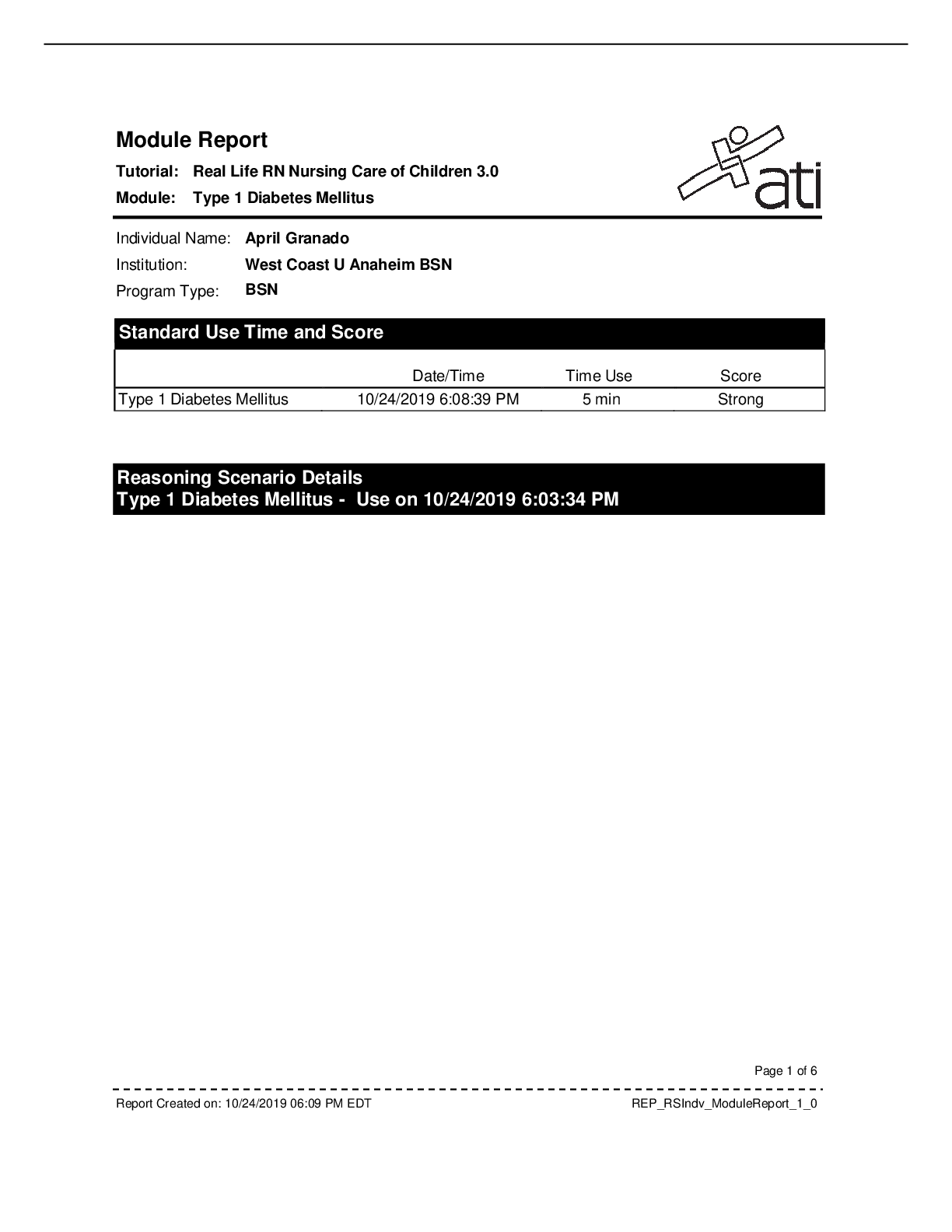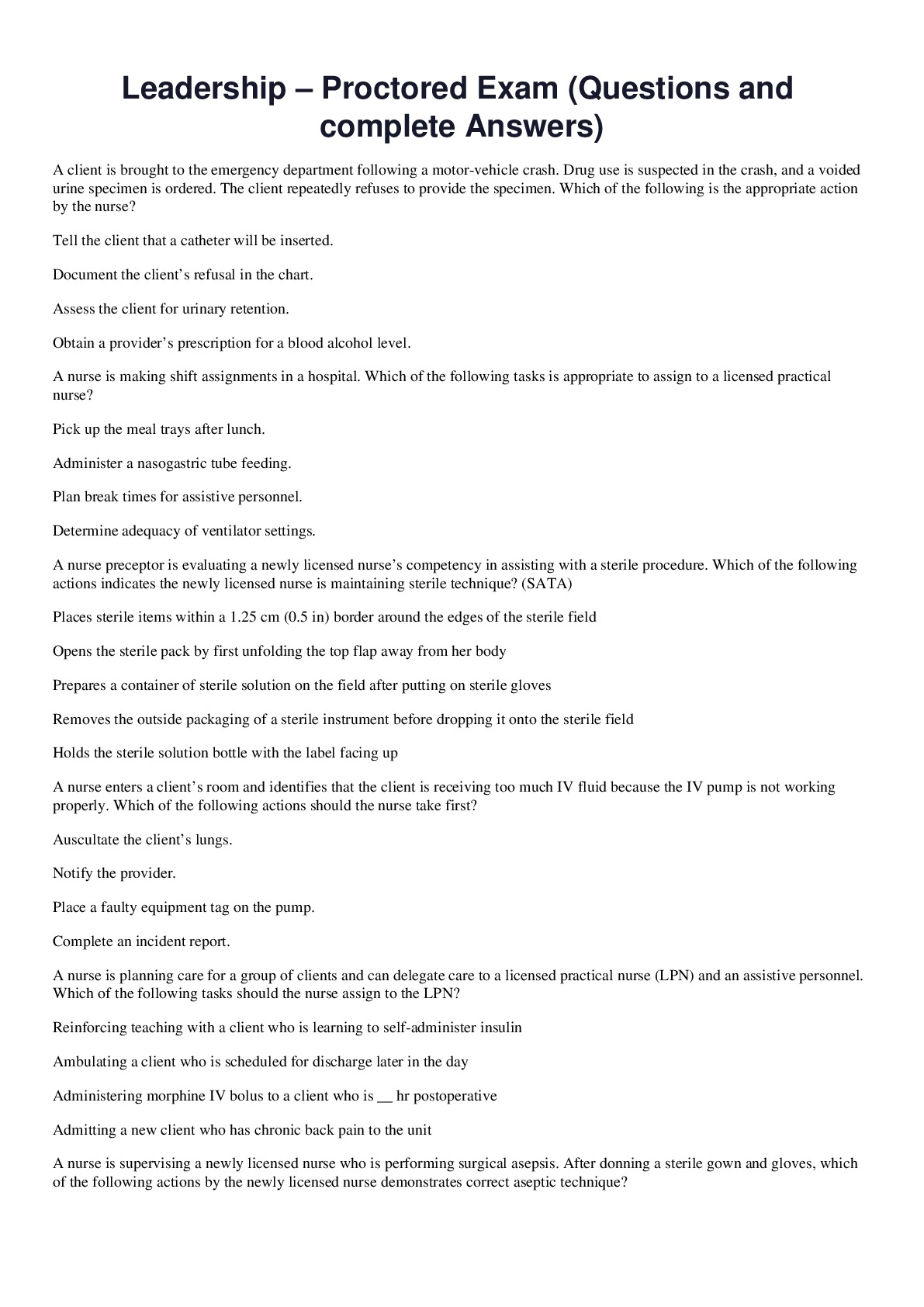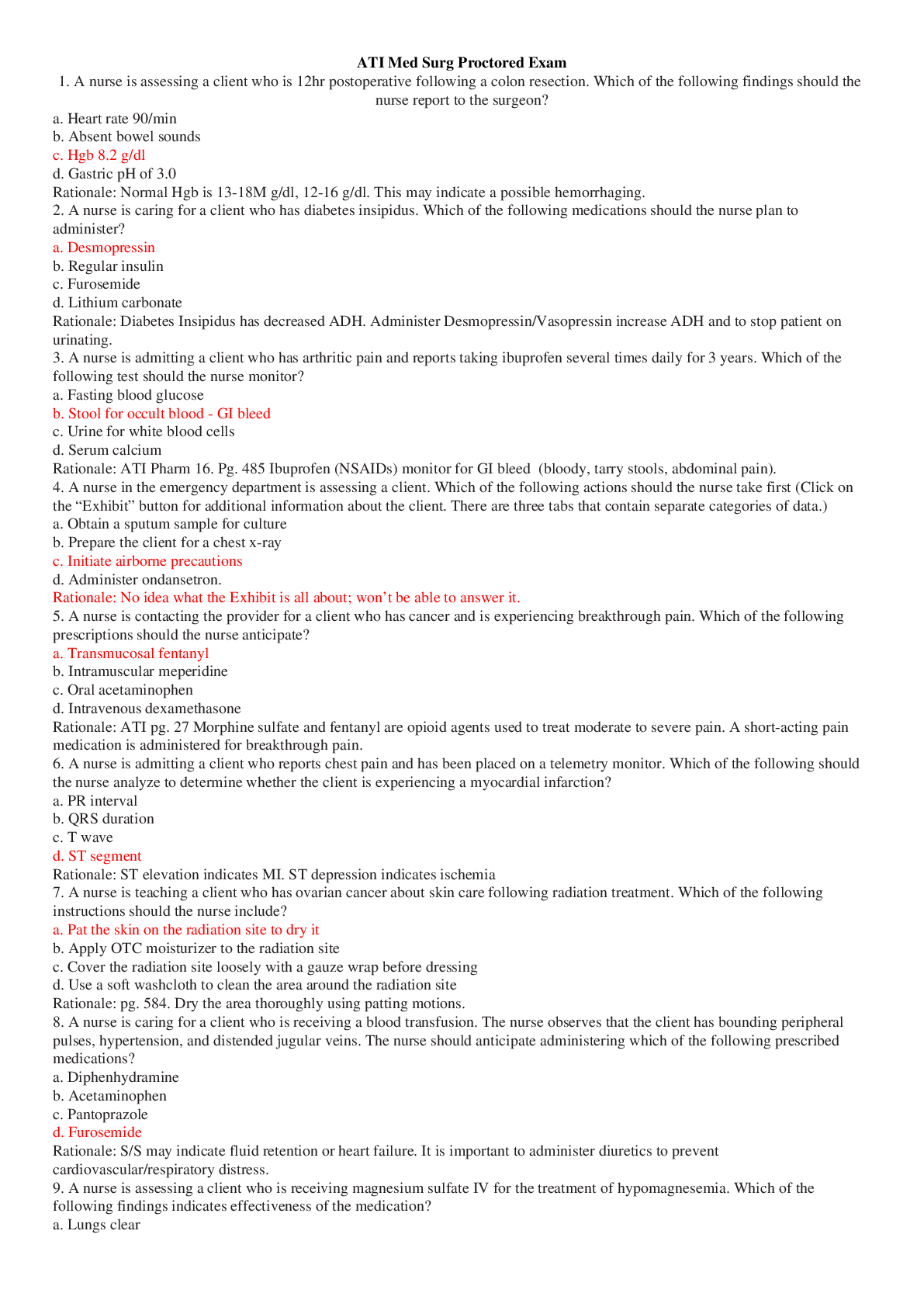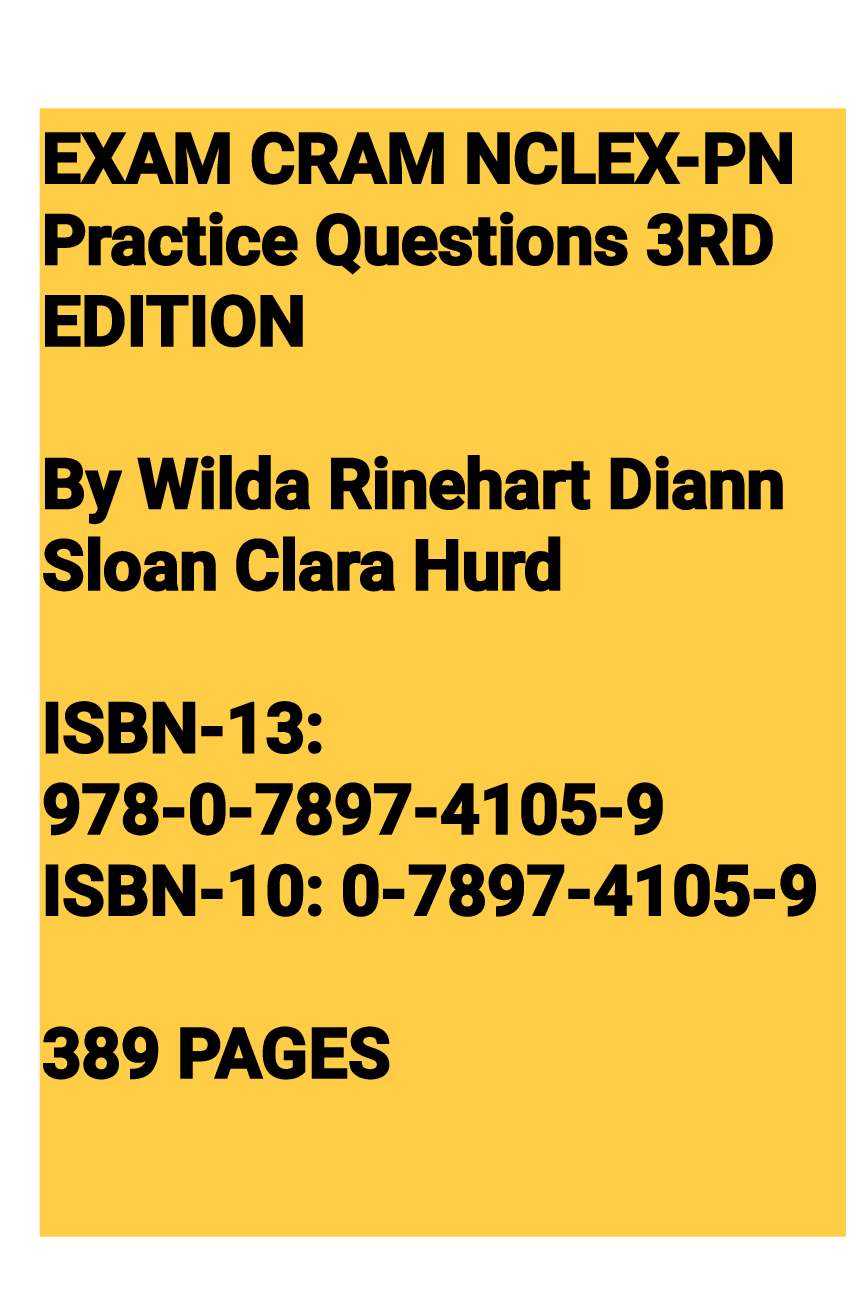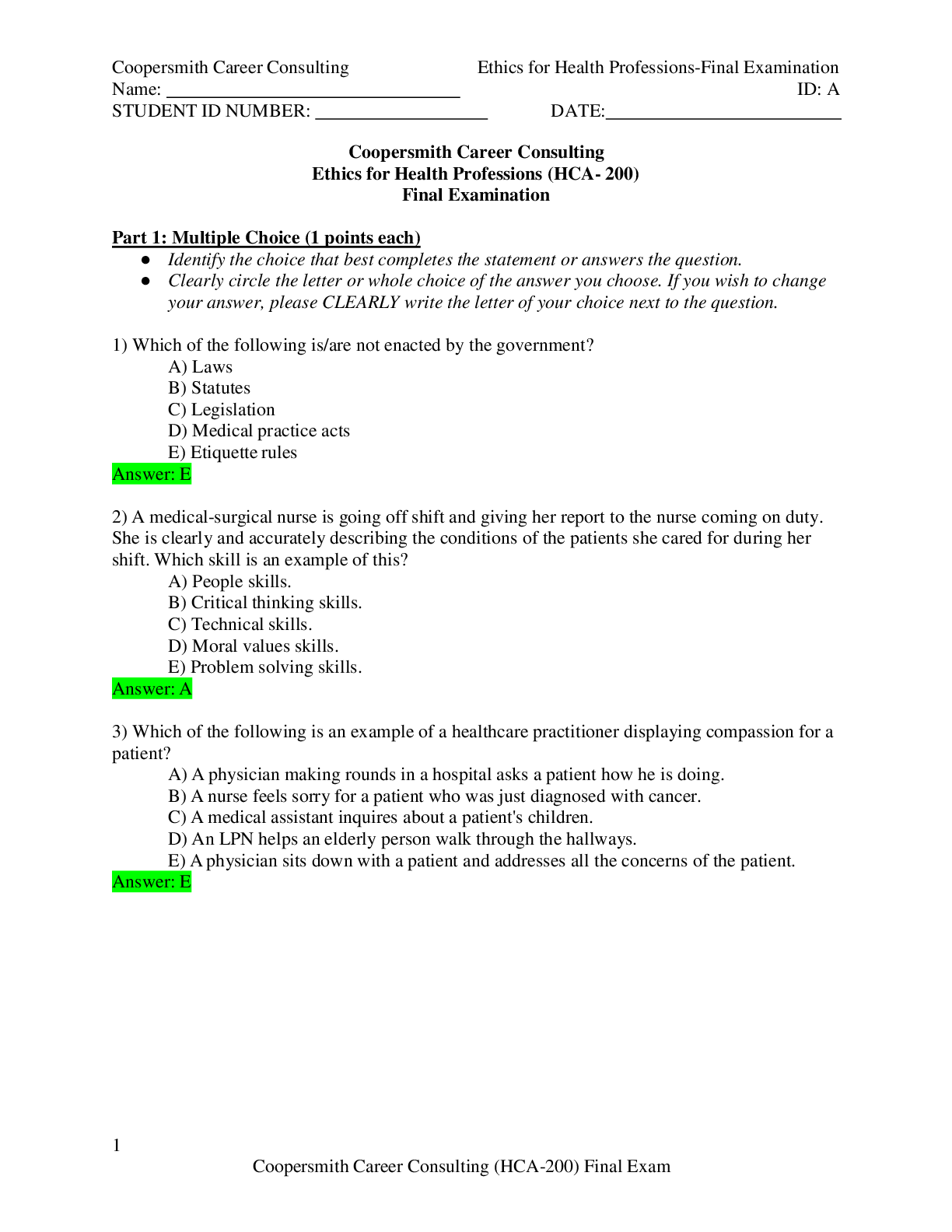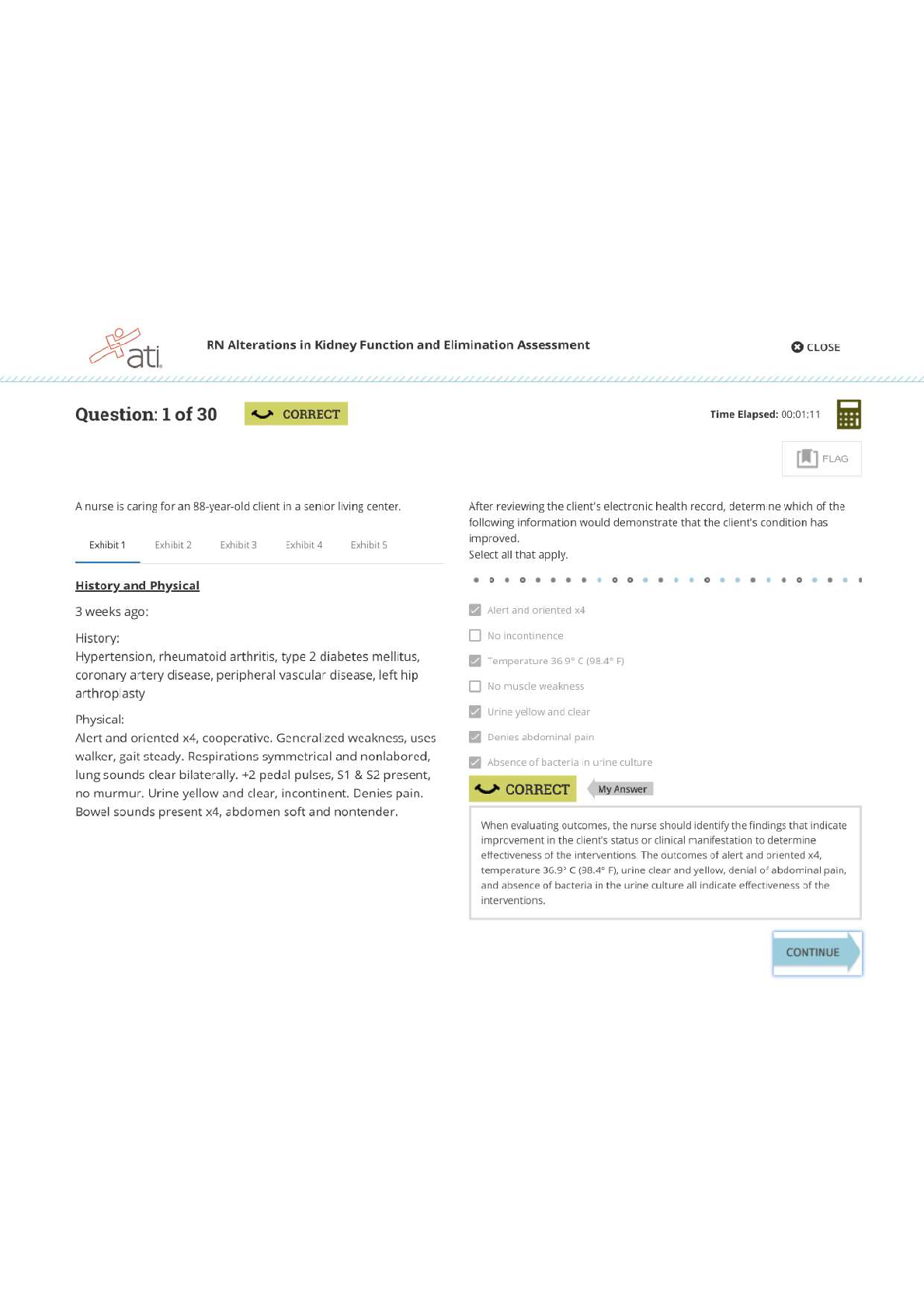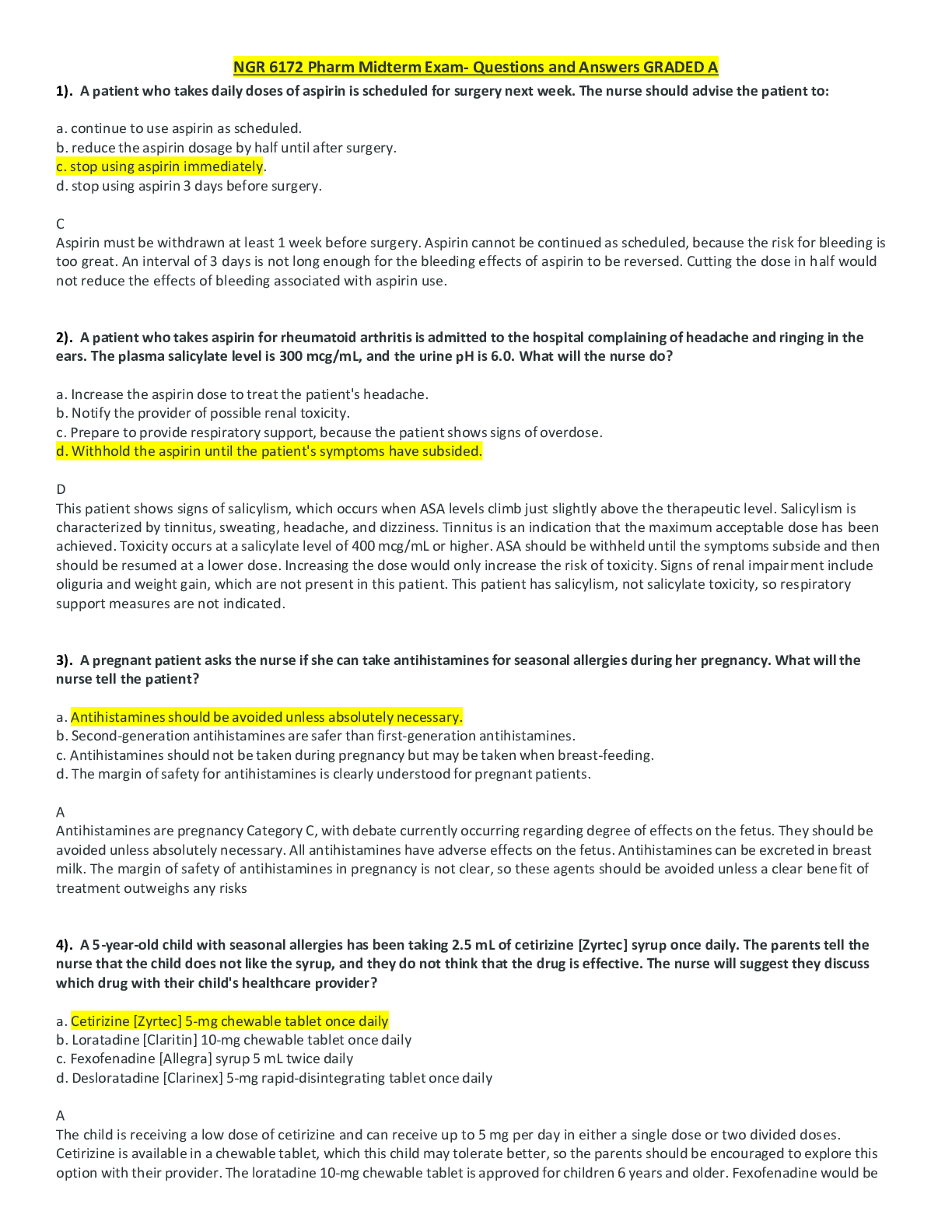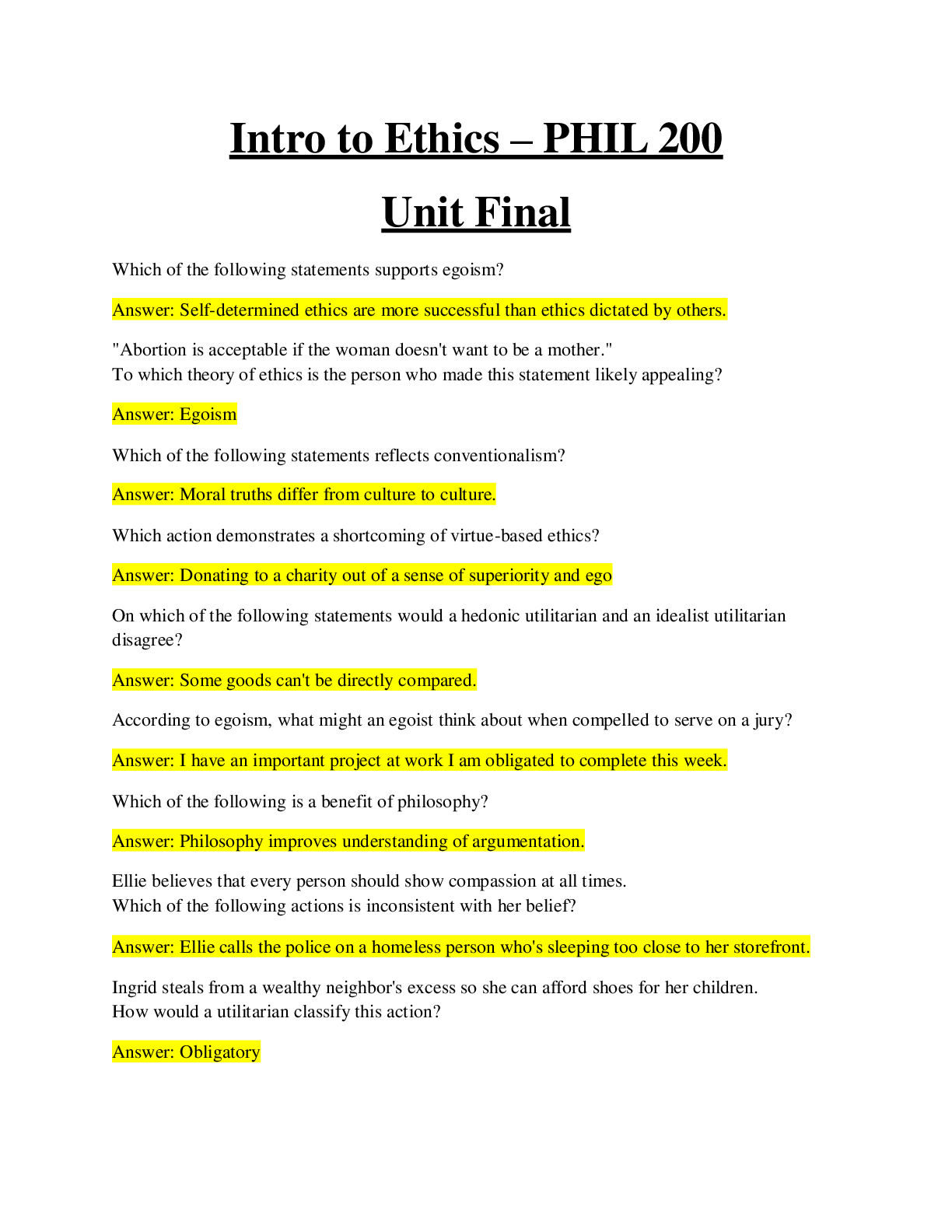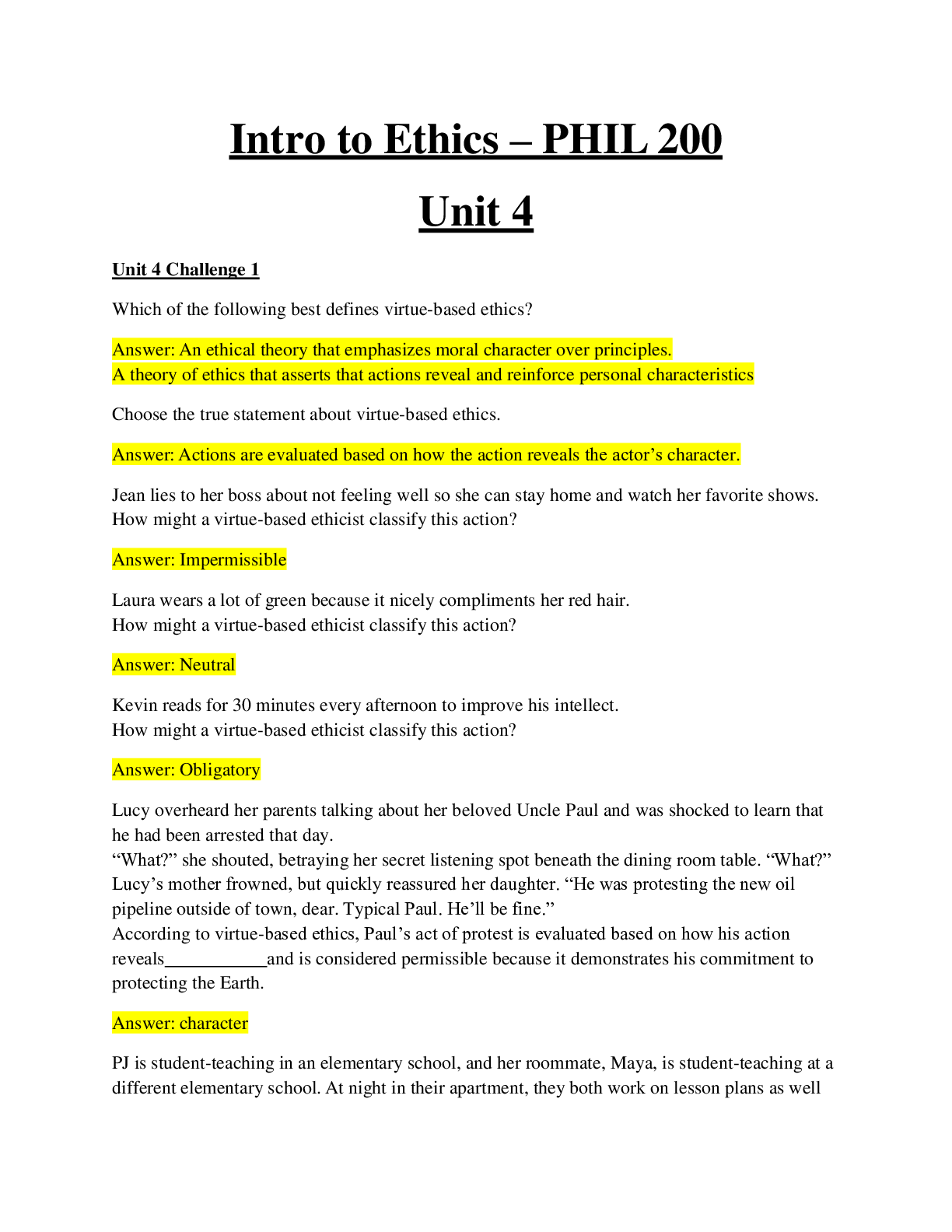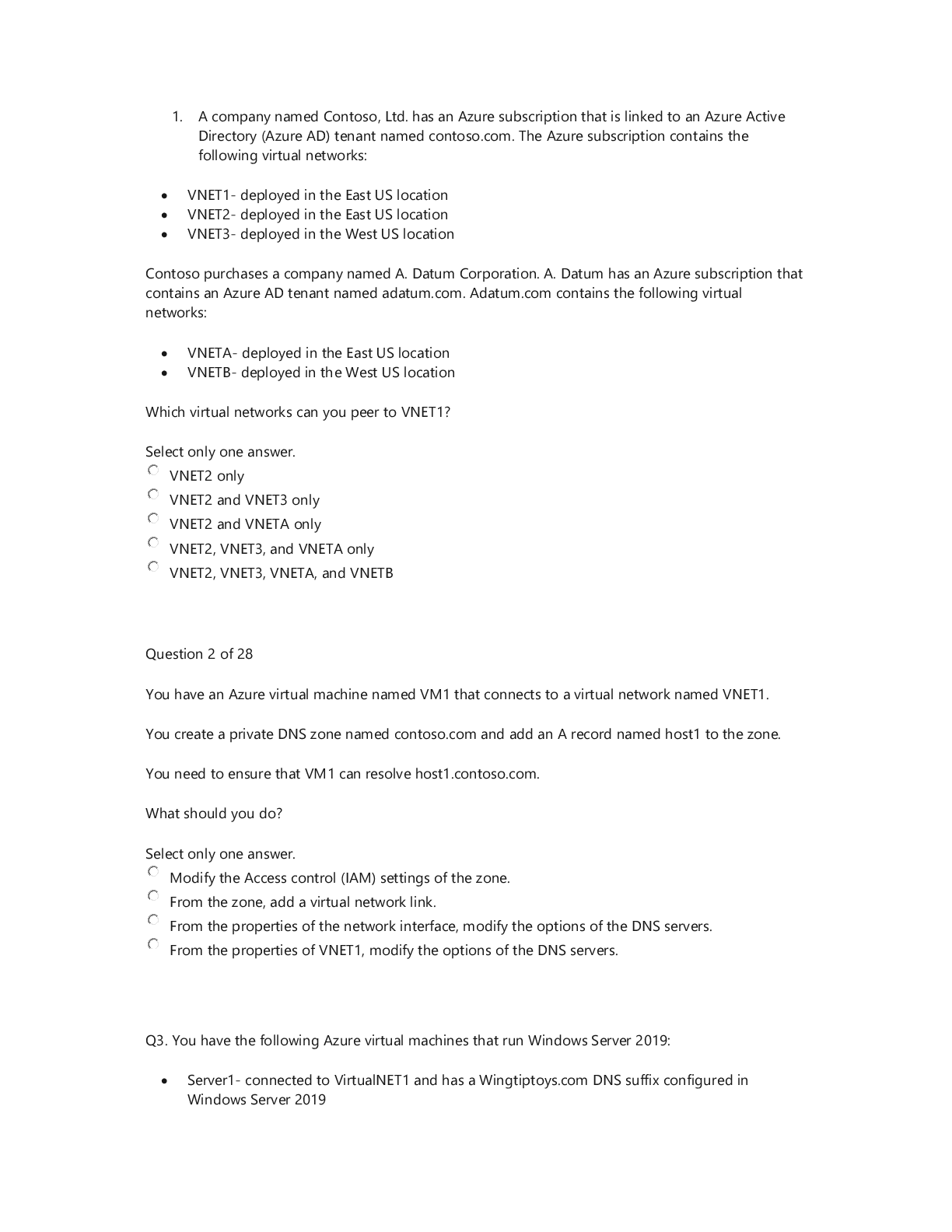ATI pediatrics proctored exam (Questions and Answers)
Document Content and Description Below
1. Parenting styles ATI pediatrics proctored exam Chapter 1: Family centered nursing care -Dictatorial or authoritarian: -Permissive: -Democratic or authoritative: Chapter 2: Physical ass... essment findings 1. Vital signs -Usually vital signs are all high except for BP -Temperature: -Pulse: -Respirations: - -Blood pressure: -Head -Fontanels should be flat -Posterior fontanel: - -Anterior fontanel: -Closes by 12-18 months 2. Teeth 3. Infant Reflexes Chapter 3: Health promotion of infants (2 days to 1 year) 1. Physical Development -Weight: -Height: -2.5 cm (1 in) per month for the first 6 months -Length: -Increases by 50% by 12 months -Dentition: -First teeth erupt between 6-10 months 2. Motor skill development o Holds hand in open position | Grasp reflex fades ▪ 3 Months o Raises head and shoulders when prone | Slight head lag o No grasp reflex | Keeps hands loosely open ▪ 4 Months o Rolls from back to side o Grasp objects with both hands ▪ 5 Months o Rolls from front to back o Palmar grasp dominantly ▪ 6 Months o Rolls from back to front o Holds bottle ▪ 7 Months o Bears full weight on feet | Sits, leaning forward on both hands o Moves objects from hand to hand ▪ 8 Months o Sits unsupported o Pincer grasp ▪ 9 Months o Pulls to a standing position | Creeps on hands and knees instead of crawling o Crude pincer grasp | Dominant hand is evident ▪ 10 Months o Prone to sitting position o Grasps rattle by its handle ▪ 11 Months o Walks while holding onto something | Walks with one hand held o Places objects into a container | Neat pincer grasp ▪ 12 Months o Stands without support briefly | Sits from standing position without assistance o Tries to build a two-block tower w/o success | Can turn pages in a book 3. Cognitive development -Piaget: sensorimotor (birth to 24 months) -Object Permanence: objects still exists when it is out of view -Occurs at 9-10 months 4. Language development -3-5 words by the age of 1 year 5. Psychosocial development -Erikson: Trust vs. Mistrust: - Learn delayed gratification -Trust is developed by meeting comfort, feeding, simulation, and caring needs -Mistrust develops if needs are inadequately or inconsistently met or if needs are continuously met before being vocalized by the infant 6. Social development -Separation Anxiety: protest when separated from parents -Begins around 4-8 months -Stranger Fear: ability to discriminate between familiar and unfamiliar people -Begins 6-8 months 7. Age appropriate activities -Rattles -Playing pat-a cake -Brightly colored toys -Playing with blocks 8. Nutrition -Breastfeeding provides a complete diet for infants during the first 6 months -Solids are introduced around 4-6 months -Iron-fortified cereal is the first to be introduced -New foods should be introduced one at a time, over a 5-7 day period to observe for allergy reactions -Juice and water usually not needed for 1st year -Appropriate finger foods: -Ripe bananas -Toast strips -Graham crackers -Cheese cubes -Noodles -Firmly cooked vegetables -Raw pieces of fruit (except grapes) 9. Injury prevention -Avoid small objects (grapes, coins, and candy) -Handles of pots and pans should be kept turned to the back of the stove -Sunscreen should be used when infants are exposed to the sun -Infants and toddlers remain in a rear-facing car seat until age 2 -Crib slats should be no farther apart than 6 months -Pillows should be kept out of the crib -Infants should be placed on their backs for sleep Chapter 4: Health Promotion of Toddlers (1 to 3 years) 1. Physical development -Weight: -30 months: 4 times the birth weight -Height: -Toddlers grow 7.5 cm (3 in) per year -Head circumference and chest circumference: -Usually equal by 1 to 2 years of age 2. Cognitive development -Piaget: sensorimotor stage transitions to preoperational stage 19 – 24 months -Object Permanence: fully developed 3. Language development -1 year: using one-word sentences -2 years: 300 words, multiword sentences by combining 2-3 words 4. Psychosocial Development -Autonomy vs. Shame and Doubt -Independence is paramount for toddlers who are attempting to do everything for themselves -Use negativism or negative responses to express their independence -Ritualism, or maintaining routines and reliability, provides a sense of comfort for toddlers as they begin to explore the environment beyond those most familiar to them 5. Age appropriate activities -Parallel play: Toddlers observe other children and then might engage in activities nearby -Appropriate activities: -Playing with blocks -Push-pull toys -Large-piece puzzles -Thick crayons -Toilet training can begin when toddlers have the sensation of needing to urinate or defecate 6. Motor skill development ▪ 15 Months o Walks without help | Creeps up stairs o Uses a cup well | Builds 2 tower blocks ▪ 18 Months o Runs clumsily | Throws overhand | Jumps in place w/ both feet | Pulls/Pushes toys o Manages a spoon w/o rotation | Turns pages 2-3 pages /time | Builds 3-4 blocks | Uses crayon to scribble spontaneously | Feeds self ▪ 24 Months (2 years) o Walks backwards | Walks up/down stairs w/ 2 feet on each step o Builds 6-7 blocks | Turns pages 1 @ a time ▪ 30 Months (2.5 years) o Balances on 1 leg | Jumps across floor / off chair w/ both feet | Walks tiptoe o Draws circles | has good hand-finger coordination 7. Nutrition -Whole milk at 1 year old -Can start drinking low-fat milk after 2 years of age -Juice consumption should be limited to 4-6 oz. per day -Foods that are potential choking hazards: -Nuts -Grapes -Hot dogs -Peanut butter -Raw carrots -Tough meats -Popcorn Chapter 5: Health Promotion of Preschoolers (3-6 years) 1. Physical development -Weight: -Gain 2-3 kg (4.5-6.5 lb) per year -Height: -Should grow 6.9-9 cm per year 2. Fine and gross motor skills ▪ 3 Years o Toe and heel walks o Tricycle o Jumps off bottom step o Stands on one foot for a few seconds ▪ 4 Years o Hops on one foot | Skips o Throws ball overhead o Catches ball reliably ▪ 5 Years o Jumps rope o Walks backward o Throws and catches a ball 3. Cognitive development -Piaget: preoperational stage -Moves from totally egocentric thoughts to social awareness and the ability to consider the viewpoint of others -Magical thinking: -Thoughts are all-powerful and can cause events to occur -Animism: -Ascribing life-like qualities to inanimate objects 4. Psychosocial development -Erikson: Initiative vs. guilt: -Preschoolers become energetic learners, despite not having all of the physical abilities necessary to be successful at everything -Guilt can occur when preschoolers believe they have misbehaved or when they are unable to accomplish a task -During stress, insecurity, or illness, preschoolers can regress to previous immature behaviors or develop habits (nose picking, bed-wetting, thumb sucking) 5. Age appropriate activities -Preschooler’s transition to associative play -Play is not highly organized, but cooperation does exist between children -Appropriate activities: -Playing ball -Putting puzzles together -Riding tricycles -Playing pretend dress up activities -Role-playing 6. Sleep and rest -On average, preschoolers need about 12 hours of sleep -Keep a consistent bedtime routine -Avoid allowing preschoolers to sleep with their parents Chapter 6: Health promotion of School-Age children (6-12 years) 1. Physical development -Weight: -Gain 2-3 kg (4.4-6.6 lb.) per year -Height: -Grows 5 cm (2 in.) per year 2. Cognitive development -Piaget: Concrete operations -Able to see the perspective of others 3. Psychosocial development -Erikson: Industry vs. Inferiority -A sense of industry is achieved through the development of skills and knowledge that allows the child to provide meaningful contributions to society -A sense of accomplishment is gained through the ability to cooperate and compete with others -Peer groups play an important part in social development 4. Age appropriate activities -Competitive and cooperative play is predominant -Play simple board and number games -Play hopscotch -Jump rope -Ride bicycles -Join organized sports (for skill building) 5. Sleep and rest -Need 9 hrs of sleep at age 11 6. Dental health -The first permanent teeth erupt around 6 years of age Chapter 7: Health promotion of Adolescents (12 to 20 years) 1. Physical development -Girls stop growing at about 2-2.5 years after the onset of menarche -In girls, sexual maturation occurs in the following order: -Breast development -Pubic hair growth -Axillary hair growth -Menstruation -In boys, sexual maturation occurs in the following order: -Testicular enlargement -Pubic hair growth -Penile enlargement -Growth of axillary hair -Facial hair growth -Vocal changes 2. Cognitive development -Piaget: Formal operations -Increasingly capable of using formal logic to make decisions 3. Psychosocial development -Erikson: Identity vs. role confusion -Adolescents develop a sense of personal identity and to come to view themselves as unique individuals 4. Age-appropriate activities -Nonviolent videogames -Nonviolent music -Sports -Caring for a pet -Reading Chapter 8: Safe Medication Administration 1. Oral -This route of medication administration is preferred for children -Avoid mixing medication with formula or putting it in a bottle of formula because the infant might not take the entire feeding, and the medication can alter the taste of the formula -Use the smallest measuring liquid medication for doses of liquid medication -Avoid measuring liquid medication in a tsp. or tbsp. -Administer the medication in the side of the mouth in small amounts -Stroke the infant under the chin to promote swallowing while holding the cheeks together 2. Otic -Children younger than years: -Pull the pinna downward and straight back -Children older than 3 years: -Pull the pinna upward and back 3. Intramuscular -Use a 22-25 gauge, 1/2-1 inch needle -Vastus lateralis is the recommended site in infants and small children -Other sites: -Ventrogluteal and deltoid 4. Intravenous -Avoid terminology such as “bee sting” or “stick” -Apply EMLA to the site for 60 minutes prior to attempt (helps numb) -Keep equipment out of site until procedure begins -Perform procedure in a treatment room (don’t do it in their room) -Allow parents to stay if they prefer -Swaddle infants -Offer nutritive sucking to infants before, during, and after the procedure Chapter 9: Pain management 1. Atraumatic measures -Use play therapy to explain procedures, allowing the child to perform the procedure on a doll or toy 2. Pharmacological measures -Give medications routinely, vs. PRN, to manage pain that is expected to last for an extended period of time 3. Pain assessment tool -Flacc: 2 months- 7 years -Faces: 3 years and older -Oucher: 3-13 years -Numeric scale: 5 years and older Chapter 10: Hospitalization, illness, and play 1. Infant -Experiences stranger anxiety between 6-18 months -Displays physical behaviors as expressions of discomfort due to inability to verbalize 2. Toddler -Limited ability to describe illness -Limited ability to follow directions -Experiences separation anxiety -Can exhibit an intense reaction to any type of procedure -Behavior can regress 3. Preschooler -Fears related to magical thinking -Can experience separation anxiety -Might believe illness and hospitalization are a punishment -Explain procedures using simple, clear language -Avoid medical jargon -Give choices when possible, such as, “Do you want your medicine in a cup or spoon?” 4. School-age child -Ability to describe pain -Increasing ability to understand cause and effect -Provide factual information -Encourage contact with peer group 5. Adolescent -Perceptions of illness severity are based on the degree of body images -Develops body image disturbance -Experiences feelings of isolation from peers -Provide factual information -Encourage contact with peer group Chapter 11: Death and Dying 1. Grief and mourning -Anticipatory grief: -When death is expected or a possible outcome -Complicated grief: -Extends for more than 1 year following the loss 2. Current stages of development -Infants/toddlers (birth-3 years): -Have little to no concept of death -Mirror parental emotions -Can regress to an earlier stage of behavior -Preschool (3-6): -Magical thinking allows for the belief that thoughts can cause an event such as death resulting in feeling guilt and shame -Interpret separation from parents as punishment for bad behavior -View dying as temporary -School-age (6-12): -Begin to have adult concept of death -Fear often displayed through uncooperative behavior -Adolescent (12-20): -Can have adult-like concept of death -Can have difficulty accepting death -Rely more on peers than the influence of parents -Can become increasingly stressed by changes in physical appearance 3. Physical manifestations of death -Sensation of heat when the body feels cool -Decreased sensation and movement in lower extremities -Swallowing difficulties -Bradycardia/hypotension -Cheyne-strokes respirations 4. After death -Allow family to stay with the body as long as they desire -Allow family to rock the infant/toddler -Remove tubes and equipment -Offer to allow family to assist with preparation of the body Chapter 12: Acute Neurological disorders 1. Meningitis -Viral (aseptic) Meningitis: supportive care for recovery -Bacterial (septic) Meningitis: contagious infection -Hib and PCV vaccines decrease the incidence -Newborns: -Poor Muscle Tone -Weak Cry -Poor Suck | Refuses Feedings -Vomiting/Diarrhea -Bulging Fontanels (late sign) -3 Months – 2 Years: -Seizures with a High-Pitched Cry -Bulging Fontanels -Poor Feedings | Vomiting -Possible nuchal rigidity -Brudzinki’s sign and Kernig’s sign not reliable for diagnosis -2 Years – Adolescence: -Seizures (often initial sign) -Nuchal rigidity -Fever/chills -Headache/vomiting -Irritability/restlessness that can progress to drowsiness/stupor -Petechiae or purpuric type rash (with meningococcal infection) -+ Brudzinski Sign: flexion of extremities with deliberate flexion of the neck -+ Kernig’s Sign: resistance to extension of the leg from a flexed position -Laboratory Tests -Blood Cultures | CBC | CSF Analysis -Viral CSF -Clear Color | Slightly Elevated WBC & Protein | Normal Glucose | - Gram -Bacterial CSF -Cloudy Color | Elevated WBC | Elevated Protein | Decreased Glucose | +Gram -Diagnostic Procedures -Lumbar Puncture (Definitive Diagnostic Test) -Empty Bladder -EMLA Cream 45min – 1-hour prior -Side-lying Position, Head Flexed, Knees Drawn up to Chest -Remain in Flat Position to prevent Leakage and Spinal HA -Nursing care: -Droplet precautions -Maintain NPO status if the client has decreased LOC -Decrease environmental stimuli -Medications: -IV antibiotics for bacterial infections -Complications: -ICP: -Newborns and Infants -Bulging or Tense Fontanels -Increased Head Circumference -High-Pitched Cry | Irritability -Distended Scalp Veins -Bradycardia | Respiratory Changes -Children -Headache -N/V -Diplopia -Seizures -Bradycardia | Respiratory Changes 2. Reye Syndrome -Affects the liver (liver dysfunction) and brain (cerebral edema) -Follows a viral illness (Influenza | Gastroenteritis | Varicella) -Giving Aspirin for treating fevers -Laboratory tests: -Elevated liver enzymes (ALT and AST) -Elevated serum ammonia -Diagnostic procedures: -Liver biopsy/CSF analysis Chapter 13: Seizures 1. Risk factors -Febrile Episode -Cerebral Edema -Intracranial Infection / Hemorrhage -Brain Tumors / Cyst -Toxins or Drugs -Lead Poisoning -Hypoglycemia -Electrolyte imbalances 2. Generalized seizures -Tonic-clonic seizures: -Also known as Grand mal -Tonic Phase (10-30 seconds) -Loss of Consciousness | Loss of Swallowing Reflex | Apnea leading to Cyanosis -Tonic Contraction of entire body: arms and legs flexed, head and neck extended -Clonic Phase (30-50 seconds) -Violent jerking movements of the body -Postictal State (30 minutes) -Remains semiconscious but arouses with difficulty and confused -No recollection of the seizure -Absence seizure: petit mal or lapses -Onset between ages 5 – 8 years and ceases by the teenage years -Loss of Consciousness lasting 5 – 10 seconds -Minimal or no change in behavior -Resembles daydreaming or Inattentiveness -Can drop items being held, but the child seldom falls -Lip Smacking | Twitching of Eyelids or Face | Slight Hand Movements -Myoclonic seizure: -Brief contraction of muscle or groups of muscle -No postictal state -Atonic or akinetic seizure: -Muscle tone is lost for a few seconds 3. Diagnostic procedures -EEG: -Abstain from caffeine for several hours prior to the procedure -Wash hair (no oils or sprays) before and after the procedure to remove electrode gel 4. Nursing care -Initiate Seizure Precautions: -Pad side rails of Bed | Crib | Wheelchair -Keep bed free of objects that could cause Injury -Have Suction and Oxygen Equipment available -During a Seizure: -Protect from Injury (move furniture away, hold head in lap) -Maintain a position to provide a patent airway -Suction Oral Secretions -Side-lying Position (decreases risk of aspiration) -Loosen restrictive clothing -Do NOT restrain the child -Do NOT put anything in the child’s mouth -Do NOT open the jaw or insert an airway during seizure -This can damage teeth, lips, or tongue -Remain with the child -Note onset, time, and characteristics of seizure -Allow seizure to end spontaneously -Post-Seizure: -Side-lying position to prevent aspiration and facilitate drainage of secretions -Check for breathing, V/S and position of head -NPO until swallowing reflex has returned 5. Medications -Antiepileptic Drugs (AEDs): -Diazepam (Valium) | Phenytoin | Carbamazepine | Valporic Acid | 6. Therapeutic procedures -Focal Resection: of an area of the brain to remove epileptogenic zone -Corpus Callostomy: separation of two hemispheres in the brain -Vagal Nerve Stimulator 7. Complications -Status Epilepticus: -Prolonged Seizure Activity that Lasts >30 minutes or Continuous seizure activity in which the client does not enter a Postictal Phase -Maintain Airway, Administer oxygen, IV access Chapter 14: Head injury 1. Physical assessment findings -Minor injury: -Vomiting -Pallor -Irritability -Lethargy/drowsiness -Severe injury: Increased ICP -Infants: -Bulging fontanel -Irritability (usually 1st sign) -High-pitched cry -Poor feeding -Children: -Nausea/headache -Forceful vomiting -Blurred vision -Seizures -Late signs: -Alterations in pupillary response -Posturing (flexion and extension) -Decreased motor response -Decreased response to painful stimuli -Cheyne-stokes respirations -Seizures -Flexion: severe dysfunction of the cerebral cortex -Extension: Severe dysfunction at the level of the midbrain 2. Nursing care -Ensure the spine is stabilized until a spinal cord injury is ruled out -Implement actions to decrease ICP: -Keep the head midline with the bed elevated 30 degrees, which will also promote venous draining -Avoid extreme flexion, extension, or rotation of the head and maintain in midline neutral position -Keep the client’s body in alignment, avoiding hip flexion/extension -Minimize oral suctioning -Nasal suctioning is contraindicated -Instruct the client to avoid coughing and blowing the nose -Insert and maintain indwelling catheter -Administer stool softeners to avoid straining 3. Medications -Mannitol: -Osmotic diuretic used to treat cerebral edema -Antiepileptic: -Used to prevent or treat seizures -Corticosteroid: dexamethasone -To help decrease edema 4. Therapeutic procedures -Craniotomy: to help relieve pressure 5. Complications -Epidural hematoma: -Bleeding between the dura and the skull -Subdural hemorrhage: -Bleeding between the dura and the arachnoid membrane -Brain herniation: -Downward shift of brain tissue Chapter 15: Cognitive and sensory impairments 1. Visual impairments -Myopia: Nearsightedness -Sees close objects clearly, but not objects in the distance -Hyperopia: Farsightedness -Sees distant objects clearly, but not objects that re close -Strabismus: -Esotropia: inward deviation of the eye -Exotropia: outward deviation of the eye -Occlusion therapy: -Patch stronger eye to make weaker eye stronger 2. Visual screening -Snellen letter, tumbling E, or picture chart -Place the client 10 feet from the chart with heels on the 10-foot mark Chapter 16: Oxygen and Inhalation therapy 1. Metered-dose Inhaler -Shake the inhaler 5-6 times -Attach the spacer -Helps facilitate proper inhalation -Take a deep breath and then exhale -Tilt the head back slightly, and press the inhaler -While pressing the inhaler, begin a slow, deep breath that lasts for 3-5 seconds -Hold the breath for 5-10 seconds 2. Dry powder inhaler -DO NOT shake 3. Chest physiotherapy -Is a set of techniques that includes manual or mechanical percussion, vibration, cough, forceful expiration (or huffing), and breathing exercises -Helps loosen respiratory secretions -Schedule treatments before meals or at least 1 hr after meals and at bedtime -Administer bronchodilator medication or nebulizer treatment prior 4 4. Hypoxemia -Early signs: -Tachypnea -Tachycardia -Restlessness -Use of accessory muscles -Nasal flaring 5. Oxygen toxicity -Can result from high concentrations of oxygen, long duration of oxygen therapy, and the child’s degree of lung disease -Hypoventilation and increased PaCO2 levels allow for rapid progression into unconscious state Chapter 17: Acute and infectious respiratory illnesses 1. Tonsillitis -Physical assessment findings: -Report of sore throat with difficulty swallowing -Mouth odor/mouth breathing -Fever -Tonsil inflammation with redness and edema -Laboratory tests: -Throat culture: -For GABHS -Medications: -Antipyretics/analgesics: acetaminophen -Antibiotics: for Tx of GABHS -Tonsillectomy: for recurring tonsillitis -Side-lying position after then elevate HOB when child is awake -Assess for evidence of bleeding: -Frequent swallowing/clearing the throat -Avoid red-colored liquids, citrus juice, and milk-based foods -Discourage coughing, throat clearing, and nose blowing in order to protect the surgical site -Avoid straws: can damage surgical site -Alert parents that there can be clots or blood-tinged mucus in vomitus -Limit activity to decrease the potential for bleeding -Fully recovery usually occurs in 14 days 2. Croup syndromes -Bacterial epiglottis (acute supraglottis): -Expected findings: -Drooling -Dysphonia: thick, muffled voice and froglike croaking sound -Dysphagia -High fever -Nursing care: -Avoid throat culture/putting tongue blade in the mouth -Prepare for intubation -Administer ABX therapy starting with IV, then transition to oral to complete a 10-day course -Droplet isolation precautions for first 24 hr after IV ABX initiated 3. Influenza A and B -Expected findings: -Sudden onset of chills and fever -Body aches -Antivirals can be given but must be within 48 hrs of onset -Amantadine, Zanamivir, Oseltamivir Chapter 18: Asthma 1. Triggers to asthma -Allergens -Smoke -Exercise -Cold air or changes in the weather or temperature 2. Expected findings -Dyspnea -Cough -Audible wheezing -Use of accessory muscles 3. Medications -Bronchodilators: albuterol -SE: tremors/tachycardia -Anticholinergics: atropine/ipratropium -Dries you up -Corticosteroids: prednisone -Rinse mouth afterwards 4. How to use a peak flow meter -Ensure the marker is zeroed -Close lips tightly around the mouthpiece -Blow out as hard and as quickly as possible -Repeat 3 more times -Record highest number 5. Complications -Status asthmaticus: -Airway obstruction that is often unresponsive to treatment -Prepare for emergency intubation Chapter 19: Cystic Fibrosis 1. Cystic fibrosis -Both biological parents carry the recessive trait for CF -Characterized by mucus glands that secrete an increase in the quantity of thick, tenacious mucus, which leads to mechanical obstruction of organs 2. Expected findings -Early manifestations: -Wheezing, rhonchi -Dry, nonproductive cough -Increased involvement: -Dyspnea -Paroxysmal cough -Obstructive emphysema and atelectasis on chest x-ray -Advanced involvement: -Cyanosis -Barrel-shaped chest -Clubbing of fingers and toes -GI findings: -Large, frothy, bulky, foul-smelling stools (steatorrhea) -Failure to gain weight or weight loss -Delayed growth patterns -Distended abdomen -Thin arms and legs -Deficiency of fat-soluble vitamins (Vitamin A,D,E,K) -Integumentary findings: -Sweat, tears, and saliva having high content of sodium and chloride 3. Diagnostic procedures -Sweat chloride test (most definitive) 4. Nursing care -Chest physiotherapy -High protein/calorie -Give pancreatic enzymes within 30 min of eating a meal or snack -Multivitamin A,D,E,and K 5. Medications -Bronchodilators: albuterol -Anticholinergics: ipratropium bromide -Dornase alfa (pulmozyme): decreases viscosity of mucus and improves lung function Chapter 20: Cardiovascular disorders 1. Defects that INCREASE pulmonary blood flow -Ventricular septal defect (VSD): -A hole in the septum between the right and left ventricle that results in increased pulmonary blood flow (left-to-right shunt) -Expected finding: -Loud, harsh murmur at the left sternal border -Atrial septal defect (ASD): -A hole in the septum between the right and left atria that results in increased pulmonary blood flow (left-to-right shunt) -Expected findings: -Loud, harsh murmur with a fixed split second heart sound -Patent ductus arteriosus (PDA): -Connection between pulmonary artery and aorta stays open after birth causing mixing of blood -Expected findings: -Murmur (machine hum) -Bounding pulses 2. Defects that DECREASE pulmonary blood flow -Tricuspid atresia: -A complete closure of the tricuspid valve that results in mixed blood flow -Tetralogy of Fallot: -Pulmonary stenosis, right ventricular hypertrophy, overriding aorta, and ventricular septal defect (PROV) 3. Obstructive defects -Pulmonary stenosis: -A narrowing of the pulmonary valve or pulmonary artery that results in obstruction of blood flow from the ventricles -Expected findings: -Systolic ejection murmur -Aortic stenosis: -A narrowing of the aortic valve -Coarctation of the aorta: -A narrowing of the lumen of the aorta -Expected findings: (BP/pulse elevated on top, but not on the bottom) -Elevated blood pressure in the arms -Bounding pulses in the upper extremities -Decreased blood pressure in the lower extremities -Cool skin of lower extremities -Weak or absent femoral pulses 4. Mixed defects -Transportation of the great arteries: -A condition in which the aorta is connected to the right ventricle instead of the left, and the pulmonary artery is connected to the left ventricle instead of the right -Expected findings: -Severe to less cyanosis depending on the size of the associated defect -Truncus arteriosus: -Failure of septum formation, resulting in a single vessel that comes off of the ventricles -Hypoplastic left heart syndrome: -Left side of the heart is underdeveloped -Expected findings: -Lethargy/cyanosis 5. Cardiac catherization -Check for allergies to iodine or shellfish -Provide for NPO status 4-6 hr prior -Locate and mark the Dorsalis pedis and posterior tibial pulses on both extremities -Prevent bleeding by maintaining the affected extremity in a straight position for 4-8 hr 6. Heart medications -Digoxin: Improves myocardial contractility -Infant: hold if pulse<90 -Children: hold if pulse <70 -Monitor for toxicity: -Bradycardia -Dysrhytmias -Nausea/vomiting -Anorexia -Ace inhibitors: captopril -Beta-blockers: metroprolol -Potassium-wasting diuretics: furosemide -Watch for hypokalemia (nausea/vomiting/dizziness) -Foods high in potassium: -Bran cereal, potatoes, tomatoes, dark green leafy veggies, bananas, orange juice, oranges, and melons 7. Hypoxemia -Immediately place the child in the knee-chest position, attempt to calm the child, and call for help 8. Infective (bacterial) endocarditis -Counsel the family of high-risk children about the need for prophylactic antibiotics prior to dental and surgical procedures 9. Rheumatic fever -Usually occurs within 2-6 weeks following an untreated or partially treated upper respiratory infection (strep throat) with GABHS -Laboratory tests: -Throat culture for GABHS -Serum antistreptolysin-O titer: -Elevated or rising titer, most reliable diagnostic test -Jones Criteria: -The diagnosis of rheumatic fever is made on the basis of modified jones criteria -The child should demonstrate the presence of 2 major criteria or the presence of 1 major and 2 minor criterion following an acute infection with GABHS infection -Major criteria: -Carditis -Subcutaneous nodules -Polyarthritis -Rash (erythema marginatum) -Chorea: involuntary muscle movements -Minor criteria: -Fever -Arthralgia 10. Kawasaki disease -Acute systemic vasculitis (inflammation of the blood vessels in the body) -Expected findings: -Acute phase: -Fever greater than 102 F lasting 5 days to 2 weeks and unresponsive to antipyretics -Irritability -Red eyes without drainage -Bright red, chapped lips -Strawberry tongue with white coating or red bumps on the posterior aspect -Red oral mucous membranes with inflammation including the pharynx -Swelling of hand and feet with red palms and soles -Sub acute phase: -Peeling skin around the nails, on the palms/soles -Medication: -Gamma globulin: IVGG -Aspirin -Client education: -Avoid live immunizations for 11 months Chapter 21: Hematologic disorders 1. Epistaxis -Have the child sit up with the head tilted slightly forward to prevent aspiration of blood -Apply pressure to the lower nose with the thumb and forefinger for at least 10 min -If needed, pack cotton or tissue into the side of the nose that is bleeding -Apply ice across the bridge of the nose if bleeding continues 2. Iron deficiency anemia -Adolescents are at risk due to poor diet, rapid growth, menses, strenuous activities, and obesity -Risk factors: -Excessive intake of cow’s milk in toddlers -Milk is not a good source of iron -Milk takes the place of iron-rich solid foods -Nursing care: -Modify the infants diet to include high iron and vitamin C -Iron supplements: -Give 1 hr before or 2 hr after milk or antacid to prevent decreased absorption -Give with Vitamin c to increase absorption -Use a straw to prevent staining of the teeth -Use a z-track method for injection -Do not massage the injection site -Tarry green stools are expected -Instruct the child to brush teeth after oral dose to minimize or prevent staining -Dietary sources of iron: -Infants: Iron-fortified cereals and formula -Older children: Dried beans, lentils, peanut butter, green leafy veggies, iron- fortified breads and flour, and red meat 3. Sickle cell anemia -SCD is an autosomal recessive genetic disorder -Primarily affects African Americans -Causes cell to be sickled shape causing increased blood viscosity, obstruction of blood flow, and tissue hypoxia -Expected findings: -Reports of pain: due to tissue ischemia -Shortness of breath/fatigue -Pallor -Jaundice -Vaso-occlusive crisis (painful episode): -Severe pain, usually in bones, joints, and abdomen -Nursing care: -Keep patient hydrated -Schedule administration of analgesics to prevent pain -Complications: -CVA 4. Hemophilia -Bleeding time is extended due to lack of a factor required for blood to clot -Hemophilia A: deficient of factor VIII -Hemophilia B: deficient of factor IX -Expected findings: -Excessive bleeding -Reports of joint pain and stiffness -Easy bruising -Activity intolerance -Laboratory tests: -Prolonged PTT -PLT and PT within expected ranges -Nursing care: -Avoid unnecessary skin punctures -Elevate and apply ice to the affected joints -Set activity restrictions to avoid injury -Low-contact sports: bowling, fishing, swimming, and golf -Use soft-bristled toothbrushes -Control bleeding episodes using RICE (rest, ice, compress, and elevate) -Complications: -Joint deformity Chapter 22: Acute infectious GI disorders 1. Rotavirus -Most common cause of diarrhea in children younger than 5 years -Manifestations: -Fever -Diarrhea for 5-7 days -Vomiting for 2 days 2. Enterobius vermicularis (pinworm) -Manifestations: -Perineal itching -Perform a tape test over anus at night 3. Diarrhea -Avoid: -Fruit juices, carbonated sodas, and gelatin -Caffeine -Chicken or beef broth -BRAT diet -Cleanse toys and childcare areas thoroughly to prevent further spread or reinfestation -Avoid undercooked or under-refrigerated food -Do not share dishes and utensils 4. Dehydration -Mild: -Capillary refill greater than 2 seconds -Possible slight thirst -Moderate: -Capillary refill between 2-4 seconds -Possible thirst and irritability -Severe: -Capillary refill >4 -Tachycardia -Extreme thirst -Very dry mucous membranes and tented skin -No tearing with sunken eyeballs -Sunken anterior fontanel -Oliguria and anuria Chapter 23: Gastrointestinal structural and inflammatory disorders 1. Cleft lip and cleft palate -Cleft lip: -Results from incomplete fusion of the oral cavity during intrauterine life -Apply elbow restraints -Cleft palate: -Results from the incomplete fusion of the palates during intrauterine life -Infant may be placed on the abdomen (prone) -For isolated cleft lip: -Use a wide-based nipple for bottle-feeding -For CP or CL and CP: -Use a specialized bottle with a one-way valve and a specially cut nipple -Avoid having the infant suck on a nipple or pacifier -Complications: -Ear infections and hearing loss -Speech and language impairment -Dental problems 2. GERD -Expected findings: -Infants: -Sitting up or forceful vomiting -Irritability -Arching of back -Children: -Difficulty swallowing -Chronic cough -Non-cardiac chest pain -Nursing care: -Small, Frequent Meals -Thicken infant’s formula with 1 tsp. to 1 tbsp. rice cereal per 1oz formula -Avoid: Caffeine | Citrus | Peppermint | Spicy or Fried Foods -Assist with weight control -HOB elevated during and after meals (at least 30 degrees) -Therapeutic procedures: -Nissen fundoplication: wraps the fundus of the stomach around the distal esophagus to decrease reflux 3. Hypertrophic pyloric stenosis -Thickening of the pyloric sphincter, which creates an obstruction -Expected findings: -Projectile vomiting -Constant hunger/dehydration -Olive-shaped mass in the right upper quadrant of the abdomen -Therapeutic procedures: -Pylorotomy 4. Hirschprung’s disease -Lack of ganglionic cells in segments of the colon resulting in decreased motility and mechanical obstruction -Expected findings: -Newborn: -Failure to pass meconium within 24-48 after birth -Episodes of vomiting bile -Refusal to eat -Abdominal distention -Child: -Foul-smelling, ribbon-like stool -Nursing care: -High-protein/calorie and low-fiber diet -Therapeutic Procedures: -Surgical removal of the aganglionic section of the bowel -Temporary colostomy can be required 5. Intussusception -Proximal segment of the bowel telescopes into a more distal segment -Abdominal mass (sausage-shaped) -Stools mixed with blood and mucus that resembles the consistency of red currant jelly -Therapeutic procedures: -Air enema 6. Appendicitis -Inflammation of the vermiform appendix -Average client age is 10 years -Expected findings: -Abdominal pain in the right lower quadrant -Decrease or absent bowel sounds -Fever -Laboratory tests: -CBC -Diagnostic procedures: -CT scans -Nursing care: -Avoid applying heat to the abdomen -Watch for pain: if patient no longer feels pain, appendix ruptured -Removal of nonruptured appendix: -Pre-op: -Give IV fluid replacement/IV antibiotic -Post-op: -Place NG tube for decompression Chapter 24: Enuresis and Urinary tract infections 1. Enuresis -Must be at least 5 years of age before there’s consideration about diagnosing enuresis -Primary enuresis: -A child has never been free of bed-wetting for any extended periods of time -Secondary enuresis: -A child who started bed-wetting after development of urinary control -Nursing care: -Have the child empty their bladder before bedtime -Encourage fluids during the day and restrict fluids in the evening -Avoid fruit and fruit drink, caffeinated or carbonated drinks after 1600 -Use positive reinforcement -Avoid punishing, scolding, or teaching the child following an incident 2. UTI -Physical assessment findings: -Infants: -Poor feeding, vomiting, or failure to gain weight -Increase in thirst -Frequent urination -Foul-smelling urine -Fever -Seizure -Pallor -Laboratory tests: -Urinalysis and urine culture and sensitivity: -Nitrates and leukocytes will be increased -Client education: -Teach females to wipe the perineal area from front to back -Suggest the use of cotton underwear -Instruct avoidance of bubble baths -Encourage frequent voiding -Empty complete bladder Chapter 25: Structural Disorders of the genitourinary tract and Reproductive system 1. Defects of the genitourinary tract -Bladder exstrophy: -Eversion of the posterior bladder through the anterior bladder wall and lower abdominal wall -Cover the exposed bladder with sterile, nonadherent dressing -Prepare the child for immediate surgery -Hypospadias: -Urethral opening located just below the glans penis, behind the glans penis, or on the ventral surface of the penile shaft -Meatus opening below the glans penis -Epispadias: -Urethra opened on dorsal surface of the penis -Phimosis: -Inability to retract foreskin of penis -Testicular torsion: -Pain is either acute or insidious in onset and radiates to the groin area Chapter 26: Renal disorders 1. Acute glomerulonephritis -Associated with GABHS -Physical assessment findings: -Cloudy, tea-colored urine -Decreased urine output -Periorbital edema -Facial edema that is worse in the morning but then spreads to extremities and abdomen with progression of the day -Mild to severe HTN -Laboratory: -Urinalysis: -Proteinuria, smoke or tea-colored urine, hematuria, increased specific gravity -Renal function: -Elevated BUN and creatinine -Antistreptolysin O (ASO) titer: -Positive indicator for the presence of streptococcal antibodies -Nursing care: -Possible restriction of sodium and fluid -Monitor for skin break down (at risk due to edema) -Encourage frequent turning and repositioning -Medications: -Diuretics and antipyretics 2. Nephrotic syndrome -Alterations in the glomerular membrane allow proteins (especially albumin) to pass into the urine, resulting in decreased serum osmotic pressure -Expected findings: -Facial and periorbital edema: decreased throughout the day -Decreased frothy urine -BP within expected range -Laboratory tests: -Urinalysis/24-hour urine: -Proteinuria: protein greater than 2+ on dipsticks -Serum chemistry: -Hypoalbuminemia: reduced serum protein and albumin -Hyperlipidemia: elevated serum lipid levels -Hemoconcentration: elevated Hgb, Hct, and platelets -Nursing care: -Monitor daily weights -Monitor edema and measure abdominal girth daily -Salt can be restricted during the edematous phase -Assess skin for breakdown -Medications: -Corticosteroids: prednisone -Diuretic: furosemide -25% albumin: increases volume and decrease edema Chapter 27: Fractures 1. Fractures -Closed or simple: -The fracture occurs without a break in the skin -Open or compound: -The fracture occurs with an open wound and bone protruding -Complicated fracture: -The fracture results in injury to other organs and tissues 2. Nursing care -Maintain ABC’s -Stabilize the injured area, avoiding unnecessary movement -Elevate the affected limb and apply ice packs (not to exceed 20 min) -Neurovascular assessment: -Sensation: Assess for numbness or tingling sensation of the extremity -Loss of sensation can indicate nerve damage -Skin Temperature: Assess the extremity for temperature. -It should be warm, not cool, to touch -Skin Color: Assess the color of the affected extremity -Check distal to the injury and look for changes of pigmentation -Capillary Refill: Press the nail beds of the affected extremity until blanching occurs -Blood return should be within 3 seconds -Pulses: Should be palpable and strong -Pulses should be equal to the pulses of the unaffected extremity -Movement: The client should be able to move the joints distal to the injury -Move Fingers or Toes 3. Casting -Elevate the cast above the level of the heart during the first 24 -Apply ice for the first 24 hours to prevent swelling -Turn and position every 2 hours (cast dries faster | prevents cast from changing shape) -Assess for increased warmth or hot spots on the cast surface (infection) -Plaster Casts: Use Palms of Hands to avoid Denting | Expose the Cast to Air -Instruct the client not to place any foreign objects inside the cast to avoid trauma to the skin 4. Traction care -Maintain body alignment -Pharmacological and Nonpharmacologic Interventions for Pain and Muscle Spasms -Assess and monitor neurovascular status -Assess pin sites for pain, redness, swelling, drainage, or odor -Weights should hang freely -Halo device: -Ensure that the wrench to release the rod is readily available when using halo traction in the event that CPR is necessary 5. Complications -Compartment syndrome: -Compression of nerves, blood vessels, and muscle inside a confined place, resulting in neuromuscular ischemia -Findings: 5 P’s: -Pain: unrelieved with elevation or analgesics, increases with passive movement -Paresthesia: numbness (early finding) -Pulselessness: distal to fracture -Paralysis: inability to move digits (nerve damage) -Pale: cold skin and cyanosis to nail beds -Osteomyelitis: -Expected findings: -Fever -Tachycardia -Edema -Pain is constant but increases with movement -Nursing actions: -Administer IV and oral ABX therapy Chapter 28: Musculoskeletal congenital disorders 1. Clubfoot -A complex deformity of the foot and ankle -Therapeutic procedures: -Series of castings 2. Legg-calve-Perthes disease -Aseptic necrosis of the femoral head can be unilateral or bilateral -Expected findings: -Intermittent painless limp -Hip stiffness -Limited ROM -Shortening of the affected leg -Maintain rest and limited weight bearing: -Abduction brace -Casts -Physical therapy -Traction -Surgical intervention: -Osteotomy of the hip or femur 3. Developmental dysplasia of the hip (DDH) -Expected findings: -Infant: -Asymmetry of gluteal and thigh folds -Limited hip abduction -Widened perineum -Positive Ortolani test: -Hip is reduced by abduction -Positive Barlow Test: -Hip is dislocated by adduction -Child: -One leg shorter than the other -Positive Trendelenburg sign: -While bearing weight on the affected side, the pelvis tilts downward -Walk with a limp -Pavlik harness: -For newborn to 6 months -Maintain harness placement for ? to 12 weeks -Check straps every 1 to 2 weeks for adjustment -Perform neurovascular and skin integrity checks (2-3 times/day) -Teach the family not to adjust the straps -Teach the family skin care: -Use an undershirt -Wear knee socks -Gently massage skin under straps -Avoid lotions/powders -Place diaper under the straps -Hip Spica cast/Bryant traction: -> 6 months -Hips flexed at 90-degree angle with buttock raised off of the bed -Evaluate hydration status frequently -Assess elimination status daily 4. Osteogenesis imperfecta -“Brittle bone disease” -An inherited condition that results in bone fractures and deformity along with restricted growth -Expected findings: -Multiple bone fractures -Blue sclera -Early hearing loss -Small, discolored teeth -Medications: -Pamidronate: Increase bone density -SE: decreases electrolytes -Nursing care: -Teach the family and client low-impact exercises 5. Scoliosis -Characterized by a lateral curvature of the spine and spinal rotation that causes rib asymmetry -Have the child bend over at the waist with arms hanging down and observe for asymmetry of ribs and flank -Bracing: -Customized braces slow the progression of the curve -Spinal fusion with rod placement: -Used for curvatures >45 degrees Chapter 29: Chronic Neuromusculoskeletal disorders 1. Cerebral palsy -Is a non-progressive impairment of motor function, especially that of muscle control, coordination, and posture -Abnormal perception and sensation; visual, hearing, and speech impairment; seizures; and cognitive disabilities -Risk factors: -Exact cause is unknown -Prenatal, perinatal, and postnatal risk factors -Expected findings: -Spastic CP (pyramidal): -Hypertonicity, increased deep tendon reflex; clonus; and poor control of motion, balance and posture -Dyskinetic CP (nonspastic, extrapyramidal): -Involuntary jerking movements that appear slow, writhing, and wormlike -Ataxic CP (nonspastic, extrapyramidal): -Poor ability to do repetitive movements -Lack of coordination with purposeful movements (ex: reaching for an object) -Medications: -Baclofen/Diazepam -Complications: -Aspiration 2. Spina Bifida -Is failure of the osseous spine to close -Meningocele: -The sac contains spinal fluid and meninges -Myelomeningocele: -The sac contains spinal fluid, meninges, and nerves -Risk factors: -Medications/substances taken during pregnancy -Insufficient folic acid intake during pregnancy -Physical assessment findings: -Protruding sac midline of the osseous spine (cystica) -Dimpling in the lumbosacral area (occulta) -Therapeutic procedures: -Closure of myelomeningocele sac is done as soon as possible to prevent complications of injury and infection -Apply a sterile, moist, nonadherent dressing with 0.9% sodium chloride on the sac, changing it every 2 hr -Place in the infant in prone position with hips flexed, legs abducted -Complications: -Skin ulceration -Latex allergy: -Also bananas, avocados, kiwi, and chestnuts -Increased intracranial pressure: -Infants: -High-pitched cry, lethargy, vomiting, bulging fontanels, and increased head circumference -Bladder issues -Orthopedic issues 3. Juvenile idiopathic arthritis -Chronic autoimmune inflammatory disease affecting joints and other tissues -Expected findings: -Joint swelling/stiffness/redness/warmth that tends to be worse in the morning or after inactivity -Nursing care: -Apply heat or warm moist packs to the child’s affected joints prior to exercise -Encourage warm baths -Medications: -NSAIDs: control pain and inflammation -Ibuprofen, naproxen, diclofenac, indomethacin, and tolmetin -DMARD: slows joint degeneration and progression of rheumatoid arthritis when NSAIDs do not work alone -Methotrexate -Corticosteroid: -Prednisone 4. Muscular dystrophy -Is a group of inherited disorders with progressive degeneration of symmetric skeletal muscle groups causing progressive muscle weakness and wasting -Duchenne (psuedohypertrophic) muscular dystrophy (DMD): -Is the most common form of MD -Onset between 3 and 5 years -Expected findings: -Muscle weakness beginning in the lower extremities -Unsteady gait, with a waddle -Lordosis -Delayed motor skill development -Frequent falling -Learning difficulties -Progressive muscle atrophy -Respiratory and cardiac difficulties as the disease progresses -Medications: -Corticosteroids -Complications: -Respiratory complications Chapter 30: Skin infections and infestations 1. Bacterial skin infections -Impetigo contagiosa: -Manifestations: -Reddish macule becomes vesicular -Erupts easily leaving moist erosion on the skin, secretions dry forming crusts -Spreads by direct -Pruritus common -Management: -Topical bactericidal or triple antibiotic ointment -Burrow’s solution -Cellulitis: -Manifestations: -Firm, swollen, red area of the skin and subcutaneous tissue -Fever/malaise -Management: -Oral or parenteral ABX -Warm/moist compress 2. Fungal skin infections -Tinea capitis (ringworm of the scalp): -Use selenium sulfide shampoos -Treat infected pets -Tinea corporis (Ringworm of the body): -Round erythematous scaling patch -Use topical antifungal (tolnaftate, Clotrimazole) -Tinea pedis (athletes foot): -Between toes or on the plantar surface of the feet 3. Skin infestations -Scabies mite (Sarcoptes scabiei): -Manifestations: -Itchy, especially at night -Rash, especially between the fingers -Thin, pencil-like marks on the skin -Infants: -Pimples on the trunk -Blisters on the palms of the hands and soles of the feet -Interventions: -Scabicide such as 5% permethrin all over body -Treat entire family and persons that have been in contact with infected person during and 60 days after infection -Wash underwear, towels, clothing, and sleepwear in hot water -Pediculosis capitis (Head lice): -Intense itching -Nits (white specs) on the hair shaft -1% permethrin shampoo -Remove nits with a nit comb; repeat in 7 days after shampoo TX -Washing clothing, bedding in hot water with detergent -Client education: -Teach the parent to bag items that cannot be laundered into tightly sealed bag for 14 days -Teach the parents to boil combs, brushes and hair accessories for 10 min or soak in lice-killing products for 1 hr -Discourage sharing of personal items Chapter 31: Dermatitis and Acne 1. Dermatitis -Diaper dermatitis -Nursing interventions: -Clean urine in the perineal area with a nonirritating cleanser -Expose the affected area to air -Use superabsorbent disposable diapers to reduce skin exposure (no cloth) -Apply a skin barrier (zinc oxide) -Poisonous plant exposure: -Cleanse exposed area as soon as possible with cold running water, then soap and water shower -Apply calamine lotion; burrow solution compresses, or natural colloidal oatmeal baths -Use topical corticosteroid gel -Seborrheic dermatitis: (thick flakes on scalp) -Treat by gently scrubbing the scalp to remove scales and crusted areas -Petrolatum, vegetable oil, or mineral oil can be helpful -Use a fine-tooth comb to remove the loosened crusts from the hair -Shampoo daily with antiseborrheic shampoo -Client education: -Encourage frequent diaper -Advise parents that their child should avoid bubble baths and harsh soaps -No talcum powder but cornstarch is okay to prevent friction -Keep fingernails trimmed short 2. Atopic dermatitis -Is a type of eczema -Dress in Cotton Clothing (avoid wool and synthetic fabrics) -Avoid excessive heat and perspiration (increase itching) -Avoid irritants (Bubble Baths | Soaps | Perfumes | Fabric Softeners) -Place gloves or cotton socks over hands for sleeping -Medications: -Antihistamines/topical corticosteroids 3. Acne -Nursing care: -Teach the child to gently wash the face and other affected areas, avoiding scrubbing and abrasive cleaners -Medications: -Trentinoin: -Avoid Sun Exposure | Use Sunscreen Daily (SPF 15 or greater) -Benzoyl peroxide: -Can bleach clothing but not skin -Isotretinoin: -SE: -Elevated cholesterol/triglycerides -Depression/suicidal ideation/violent behaviors -Contraindicated in women who are not taking oral contraceptives Chapter 32: Burns 1. Stages of burns -First degree: -Superficial: -Damage to the epidermis (sunburn) -Pink to red in color with no blisters -Blanches with pressure -Painful -Second degree: -Superficial partial thickness: -Damage to the entire epidermis -Dermal elements are intact -Painful, moist, red in color with blisters -Blanches with pressure -Sensitive to temperature changes, exposure to air, and light touch -Deep partial thickness: -Damage to the entire epidermis and some parts of the dermis -Sweat glands and hair follicles remain intact -Red to white in color, with blisters -Blanches with pressure -Painful -Sensitive to temperature changes and light touch -Third degree: -Full thickness: -Damage to the entire epidermis and dermis and possible damage to the subcutaneous tissue -Red to tan, black, brown, or waxy white in color -Dry, leathery appearance -Fourth-degree: -Deep full thickness: -Damage to all layers of the skin that extends to muscle, bone, and fascia -No pain is present 2. Nursing care -Check immunization status, and determine the need for immunization -Administer tetanus vaccine if it has been more than 5 years -Educate the family to avoid using greasy lotions or butter on burns -Maintain airway and ventilation -Initiate IV access with large-bore catheter -Multiple access points may be necessary -Fluid replacement is important during the first 24 hours -Isotonic crystalloid solutions, such as 0.9% sodium chloride or lactated ringer’s are used during the early stage of burn recovery -Maintain urine output of 0.5 to 1 ml/kg/hr is <30 kg -Maintain urine output of 30 ml/hr for >30 kg -Manage pain: -Use IV opioid -Provide nutritional support: -Increase caloric intake/protein -Vitamin A, C, and zinc for wound healing -Maintain active and passive range of motion 3. Medications -Topical agents: -Silver sulfadiazine/ Mafenide acetate -Use with 2nd and 3rd degree burns -Apply to cleansed, debrided area -Wear sterile gloves for applications -Bacitracin: -Use for prevention of secondary infection 4. Skin coverings -Biologic skin coverings: -Allograft (homograft): -Skin from human cadavers that is used for partial and full thickness burn wounds -Xenograft: -Obtained from animals: pigs (partial thickness burns) -Permanent skin coverings: -Autografts: -Client’s skin Chapter 33: Diabetes Mellitus 1. Risk factors -Genetics -Toxins/viruses: can destroy the beta cells ->type 1 DM -Obesity/physical inactivity/HTN -> type 2 DM 2. Expected findings -Hypoglycemia: blood glucose <60 -Hunger, lightheadedness, and shakiness -Pale, cool skin/diaphoresis -Decreasing LOC -Slurred speech -Headache and blurred vision -Seizures leading to coma -Hyperglycemia: blood glucose >250 -Thirst -Polyuria (early sign)/oliguria (late sign) -Nausea, vomiting, and abdominal pain -Skin that is warm, dry, and flushed with poor turgor -Dry mucous membranes -Confusion -Weakness -Lethargy -Weak pulse -Diminished reflexes -Rapid, deep respirations with acetone/fruit odor due to ketones (Kussmaul respirations) 3. Laboratory tests -Diagnostic criteria for diabetes: -An 8-hr fasting blood glucose level of 126 or more -Random blood glucose of 200 or more with classic sign of diabetes -An oral glucose tolerance test of 200 or more in the 2 hr sample -Glycosylated hemoglobin (HbA1c): -Expected reference range is 4%-5.9% -Acceptable target for children who have diabetes: 6.5%-8% -If >7%: not regulating sugar well 4. Nursing care -Trimming toenails straight across with clippers and filing edges with a nail file -Caution the child against wearing sandals, walking barefoot, or wearing socks without socks -Dry feet completely -Can use mild foot powder: cornstarch -Never use commercial remedies for removing callus/corn -Sock: cotton or wool -No heating pads for feet -Teach the child illness management: -Monitor blood glucose and urinary ketone levels every 3 hr -Continue to take insulin or oral Antidiabetic agents -Encourage sugar-free, noncaffeinated liquids to prevent dehydration -Call the provider for the following: -Blood glucose >240 -Fever 102F -Positive ketones in the urine -Disorientation or confusion occurs -Rapid breathing is experienced -Treat with 10-15 g simple carbohydrates (1tbsp sugar) -Ex: 4 OZ orange juice/8OZ milk -If the child is unconscious or unable to swallow: -Administer glucagon SC or IM -Administer simple carbohydrates as soon as tolerated 5. Medications 6. Complications -DKA: ->330 mg/dL -Expected findings: -Ketone levels in the blood and urine -Fruity scent to the breath -Mental confusion -Dyspnea -Nausea and vomiting -Electrolyte imbalances: Metabolic acidosis/hyperkalemia -Nursing actions: -Monitor serum potassium levels -Administer sodium bicarbonate by slow IV infusion for severe acidosis (pH <7) -Have a cardiac monitor -Kidney disease -Eye disease -Neurologic complications Chapter 34: Growth Hormone deficiency 1. Expected findings -Short stature but proportional height and weight -Delayed epiphyseal closure -Delayed sexual development 2. Medications -Somatropin: -Given until epiphyseal plate closes -Administer SC 1. Contraindications -DTaP: Chapter 35: Immunizations -IPV: -MMR: -Occurrence of encephalopathy within 7 days following prior doses of the vaccine -Anaphylactic reaction to neomycin, streptomycin or polymyxin B -Anaphylactic reaction to eggs, gelatin, and neomycin -Influenza vaccine: -Hypersensitivity to eggs -Varicella: -If taking corticosteroids -The common cold and other minor illnesses are not contraindications to immunizations -Severe febrile illness is a contraindication to all immunizations -Do not administer live virus vaccines, such as varicella or MMR, to a child who is severely Immunocompromised 2. Nursing administration -Give IM immunizations in the Vastus lateralis or ventrogluteal muscle in infants and young children -Give IM immunization in the deltoid muscle for older children/adolescents -Give infants a concentrated oral sucrose solution 2 min prior to, during, and 3 min after immunization administration -Document date, route, site of immunization, lot number, manufacturer and exp. Date Chapter 36: Communicable Diseases 1. Conjunctivitis -Spread: Direct contact (viral/bacterial -Expected findings: -Pink or red color in the sclera of the eyes -Crusting of the eyelids in the morning 2. Epstein-Barr virus (EBV)/mononucleosis -Spread: saliva -Expected findings for infectious mononucleosis: -Fever -Swollen lymph glands -Splenomegaly -Hepatic involvement -Complications: ruptured spleen (no contact sports) 3. Erythema infectiosum (fifth disease)/parvovirus B19 -Spread: droplet/blood -Expected findings: -Rash (7 days to several weeks): -Red rash on face (slapped cheek), which appears from day 1 to 4 4. Mumps/paramyxovirus -Spread: droplet -Expected findings: -Painful, swollen parotid glands 5. Pertussis (whooping cough)/Bordetella pertussis -Spread: direct contact/droplet/indirect contact with freshly contaminated articles -Expected findings: -Common cold manifestations: -Runny nose/congestion, sneezing, mild fever, and mild cough -Severe coughing starts in 1-2 weeks: -Coughing fits -Violent and rapid coughing -Loud “whooping” sound upon inspiration 6. Rubella (German measles)/rubella virus -Spread: droplet -Expected findings: -Red rash that starts on the face and spreads to the rest of the body, lasting 2- 3 days -Complications: -Birth defects (deafness; heart defects; mental, liver, and spleen damage) in fetus of women infected during pregnancy 7. Rubeola (measles)/rubeola virus -Spread: droplet -Expected findings: -Cough, runny nose, red eyes, and sore throat -Rash: -Koplik spots (tiny white spots) appear in mouth 2 days before rash 8. Varicella (chicken pox)/varicella-zoster virus -Spread: droplet (airborne) -Expected findings: -Manifestations 1-2 days prior to rash: -Fever/fatigue -Rash: -Macules start in center of trunk, spreading to the face and proximal extremities -Progresses from macules, to papules, to vesicles, and crust formations follow 9. Nursing care -Do not administer aspirin, due to the risk of Reye Syndrome -Provide calamine lotion for topical relief -Keep the child’s fingernails clean and short 10. Medications -Antihistamine -Antiviral therapy: -Acyclovir for high-risk clients who have varicella Chapter 37: Otitis Media 1. Risk factors -Most common in the first 24 months of life and again when children enter school ages (5-6) 2. Medications -Acetaminophen/ibuprofen: -For analgesia and reduce fever -Antibiotics 3. Therapeutic procedures -Myringotomy and placement of tympanoplasty tubes -A small incision is made in the tympanic membrane -The tubes come out spontaneously (usually in 6-12 months) -Instruct parents to notify the provider when tubes come out -This is usually does not require replacement of tubes Chapter 38: HIV/AIDS 1. HIV/AIDS -HIV infection is a viral infection in which the virus primarily infects a specific subset of T-lymphocytes, the CD4 T cell causing immune dysfunction -This leads to organ dysfunction and a variety of opportunistic illnesses in a weakened host 2. Expected findings -Mild: -Lymphadenopathy -Hepatomegaly -Splenomegaly -Dermatitis -Parotitis -Severe: -Multiple serious bacterial infections -Kaposi’s sarcoma: skin infection -Pneumocystis carinii pneumonia -Wasting syndrome 3. Laboratory findings -Ages >6: -CD4 T-lymphocyte count= lower than 500=some immunosuppression -CD4 T-lymphocyte count=lower than 200=severe immunosuppression 4. Nursing care -Diet high in calories and protein -Provide good oral care -Prevent infection using standard precautions -Does not need special precautions -Teach the child and parents to avoid individuals who have colds/infections/viruses -Encourage immunizations: -Pneumococcal vaccine and yearly influenza vaccine 5. Medications -Antiretroviral -Antibiotics -IV gamma globulin Chapter 39: Organ neoplasms 1. Wilms’ tumor (Nephroblastoma) -Is a malignancy that occurs in the kidneys or abdomen -Tumor is usually unilateral -Most cases diagnosed between 2-3 years of age -Metastasis is rare -Expected findings: -Painless, firm, nontender abdominal swelling or mass -Fatigue, malaise, and weight loss -Fever -Diagnostic tests: -Abdominal ultrasonography -Abdominal and chest CT scan -Bone marrow aspiration (rule out metastasis) -Nursing care: -IF WILM’S TUMOR IS SUSPECTED DO NOT PALPATE THE ABDOMEN (can cause spread) 2. Neuroblastoma -Is a malignancy that occurs in the adrenal gland -Usually manifested during toddler years -Half of all cases have metastasized before diagnosis -Expected findings: -Half of children who have a Neuroblastoma have few findings -Manifestations of metastasis: -Ill appearance -Periorbital ecchymosis -Bone pain -Irritability -Diagnostic procedures: -Skull, neck, chest, abdominal and bone CT scans -Bone marrow aspiration (rule out metastasis) 3. Chemotherapy -Provide an antiemetic prior to administration -Observe the mouth for mucosal ulcerations -Educate about the SE of chemotherapy: -Mouth sores -Loss of appetite -Nausea/vomiting -Hair loss -Diarrhea/constipation -Increased risk of infection -Easy bruising or bleeding -Fatigue 4. Radiation -Nurse: wear lead aprons -Instruct the child and family not to wash off marks on the skin that outline the targeted areas -Avoid use of soaps, creams, lotions, and powders unless prescribed -Keep the areas protected from the sun by wearing a hat and long-sleeved shirts 5. Complications -Encourage the child to avoid crowds while undergoing chemotherapy -Avoid fresh fruits and vegetables -Avoid invasive procedures -Administer filgrastim: -Is a granulocyte colony-stimulating factor that stimulates WBC production -Given SC daily -Administer epoetin alfa: -Given SC 2-3 times per week -Stimulate RBC production -Administer Oprelvekin -Given SC daily -For PLT formation -Encourage the use of soft toothbrush -Mucositis and dry mouth: -Lubricate the child’s lips -Avoid hydrogen peroxide and lemon glycerin swabs Chapter 40: Blood Neoplasms 1. Leukemia -Is the term of a group of malignancies that affect the bone marrow and lymphatic system -Diagnostic procedures: -Bone marrow aspiration or biopsy analysis: -Topical anesthetic such as EMLA cream 45 min-1 hr prior -CSF analysis: -Have the child empty their bladder -EMLA cream 45 min-1 hr prior -Side-lying position with the head flexed and knees drawn up toward the chest, and assist in maintaining the position (during procedure) -Remain in bed 4-8 hr in a flat position to prevent leakage and a resulting spinal headache (after) Chapter 43: Pediatric Emergencies 1. Obstructed airway -Children/adolescents: -Use abdominal thrusts -Infants: -Combination of back blows and chest thrusts -Remove any visual obstruction or large debris from the mouth, but do not perform a blind finger sweep 2. Drowning -Encourage parents of toddlers to lock toilet seats when their child is at home -Instruct parents to not leave the child unattended in the bathtub -Inform parents not to leave the child unattended in a swimming pool, even if the child can swim -Encourage parents to provide life jackets when boating 3. SIDS -Risk factors: -Maternal smoking during pregnancy -Co-sleeping with parent or adult -Prone or side-lying sleeping -Low birth weight -Education on risk reduction: -Place the infant on the back for sleep -Avoid exposure to tobacco smoke -Prevent overheating -Use a firm, tight-fitting mattress in the infant’s crib -Remove pillows, quilts, and stuffed animals from the crib during sleep -Offer pacifier at naps and night -Encourage breastfeeding -Avoid co-sleeping 4. Poisoning -1st thing to do is call poison control center -Acetaminophen: N-acetylcysteine given orally -Supplemental iron: -Emesis or lavage -Chelation therapy using deferoxamine mesylate Chapter 44: Psychosocial issues of infants, children and adolescents 1. ADHD -Expected findings: -Inattention: -Difficulty in sustaining attention -Easily distracted -Forgetfulness -Hyperactivity -Impulsivity -Medications: -Methylphenidate, Dextroamphetamine: -Increases dopamine and norepinephrine levels -Give 30 min before meals -Give last dose of the day prior to 1800 to prevent insomnia -Atomoxetine 2. Autism spectrum disorder -Expected findings: 7-Distress when routines are changed -Unusual attachment to objects -Delayed or absent language development -Withdrawn, labile mood -Avoiding eye contact -Nursing care: -Decrease environmental stimulation -Introduce the child to new situations slowly -Encourage support groups for parents [Show More]
Last updated: 1 year ago
Preview 1 out of 45 pages
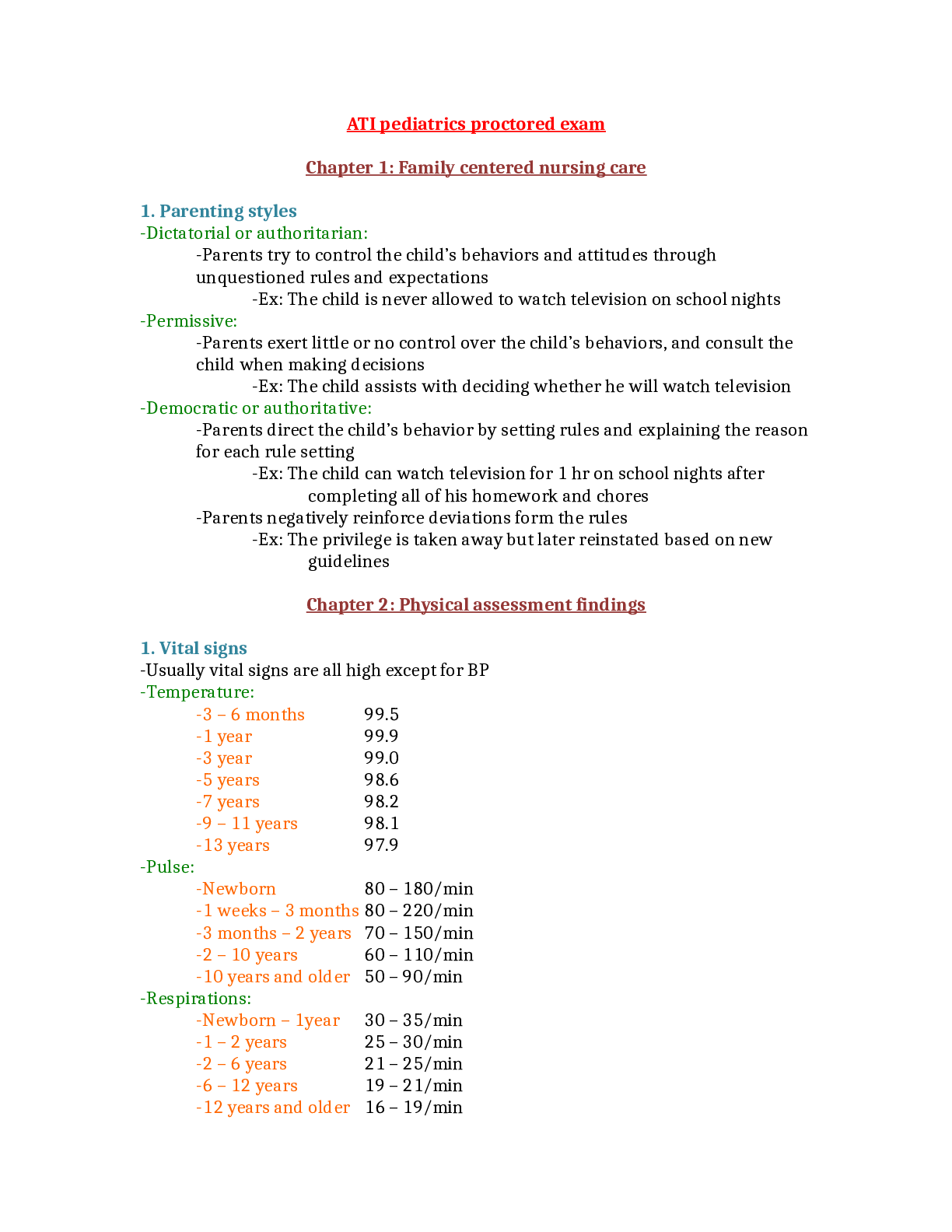
Reviews( 0 )
Document information
Connected school, study & course
About the document
Uploaded On
Aug 08, 2021
Number of pages
45
Written in
Additional information
This document has been written for:
Uploaded
Aug 08, 2021
Downloads
0
Views
36

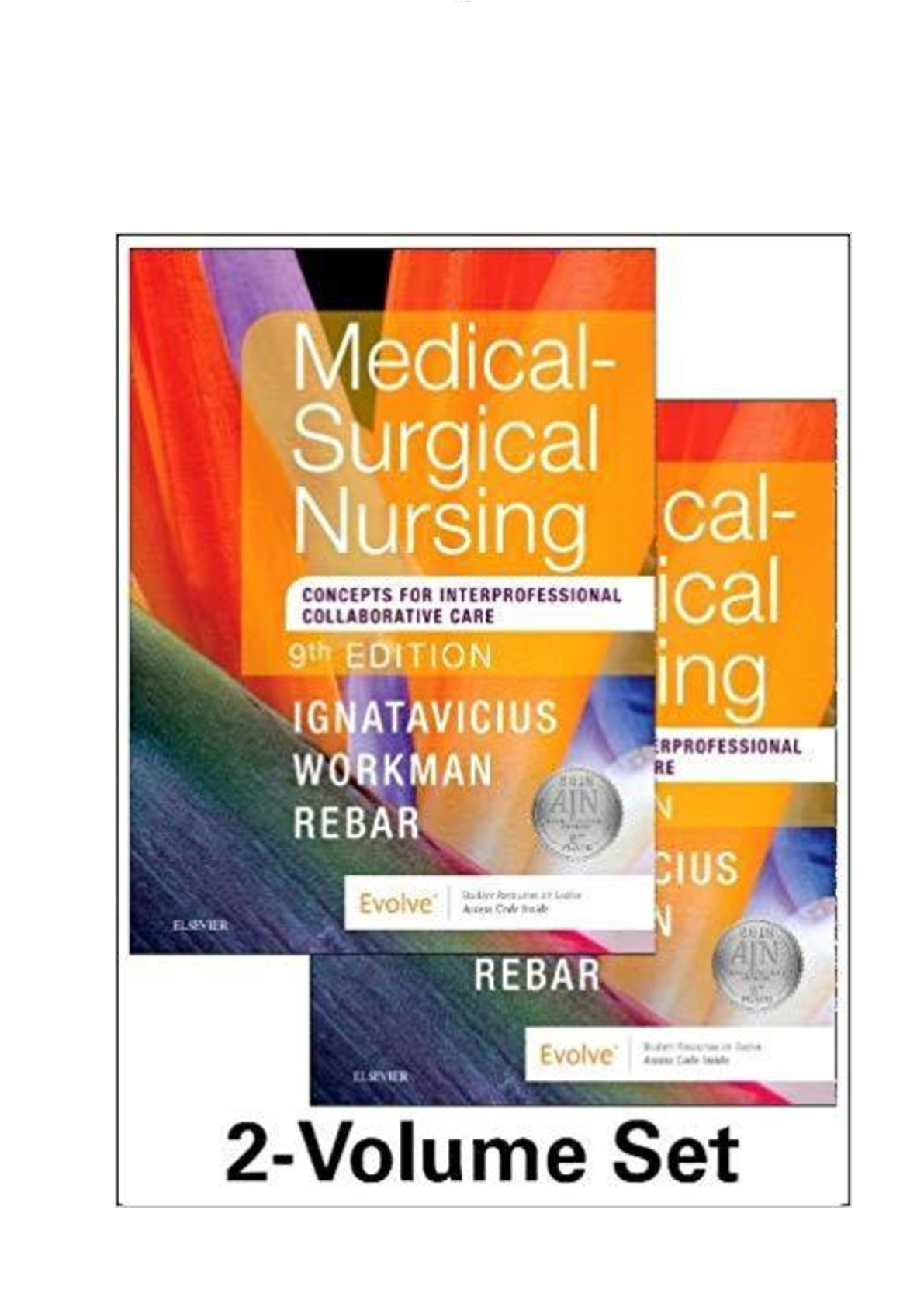
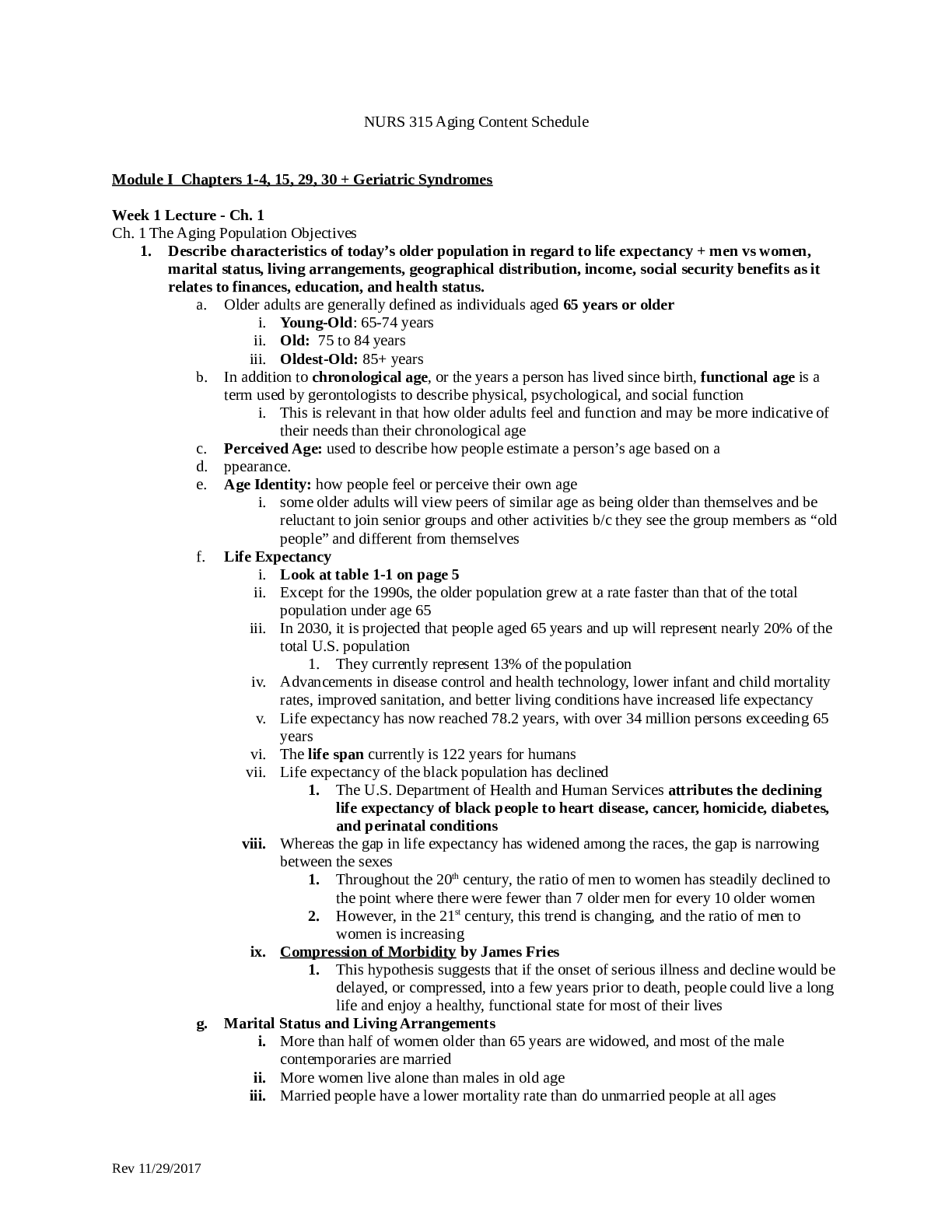

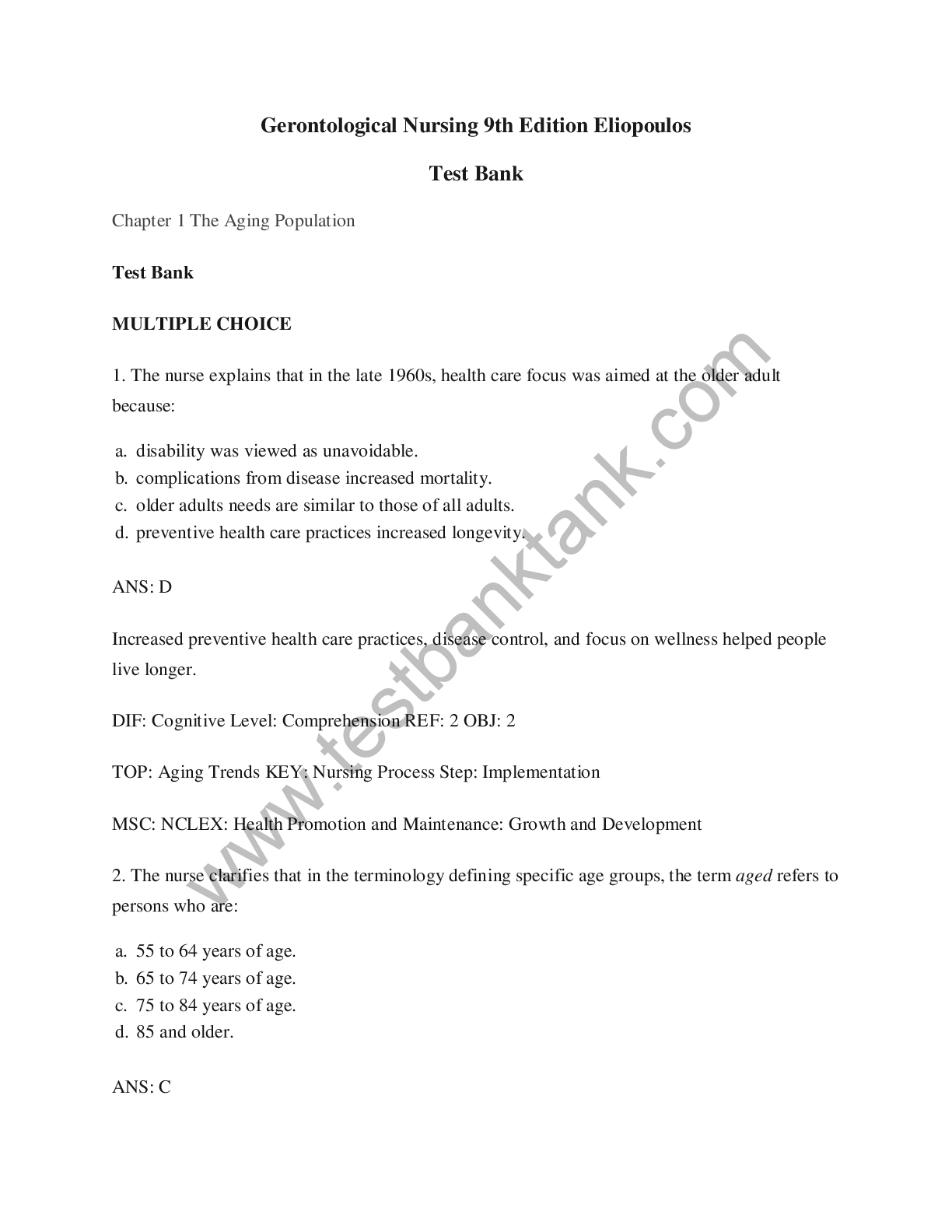
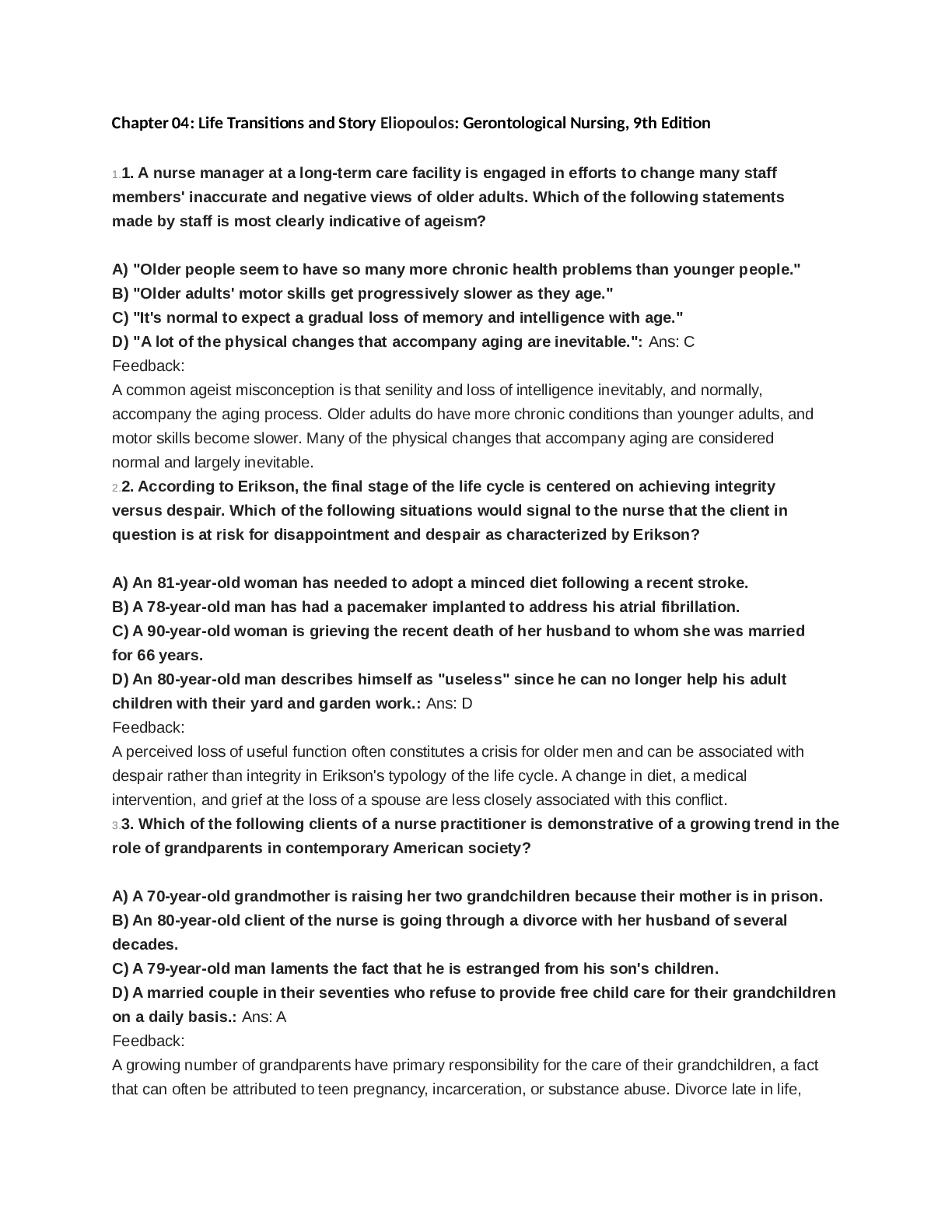


.png)
